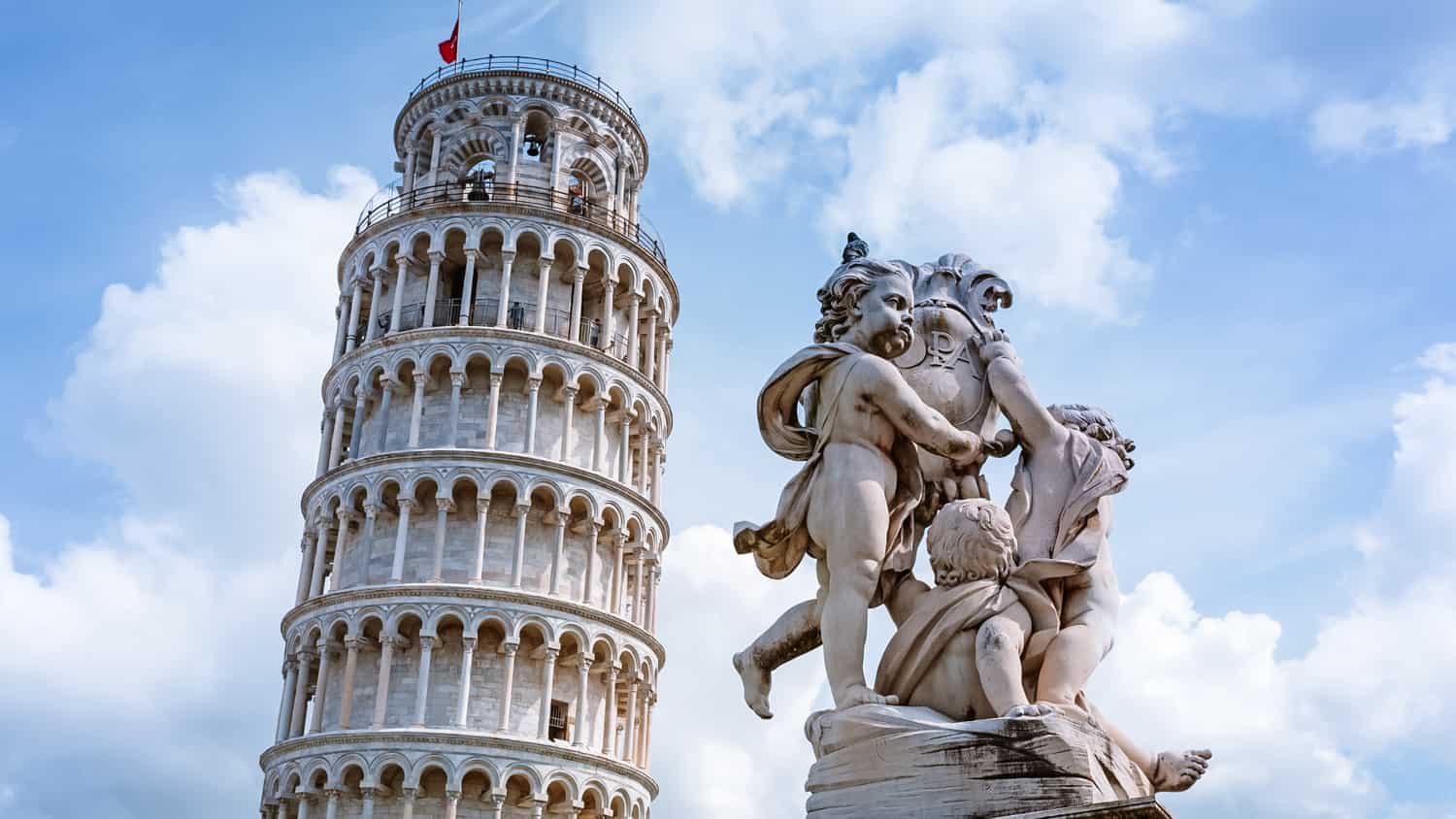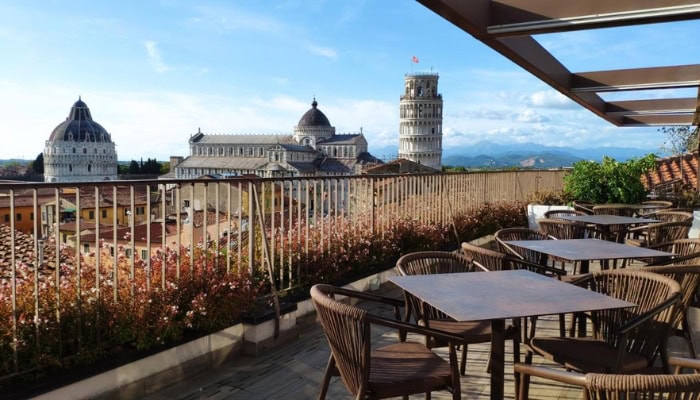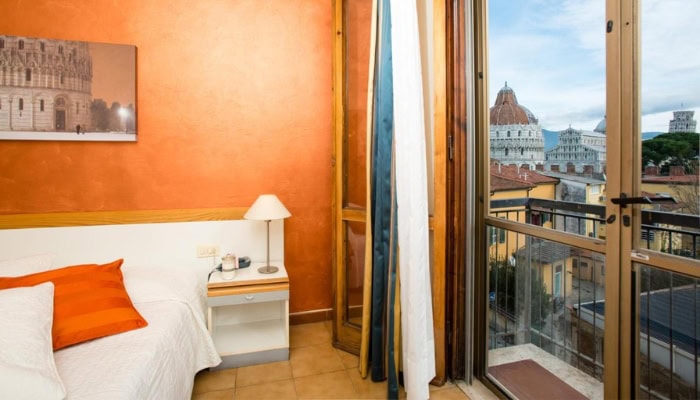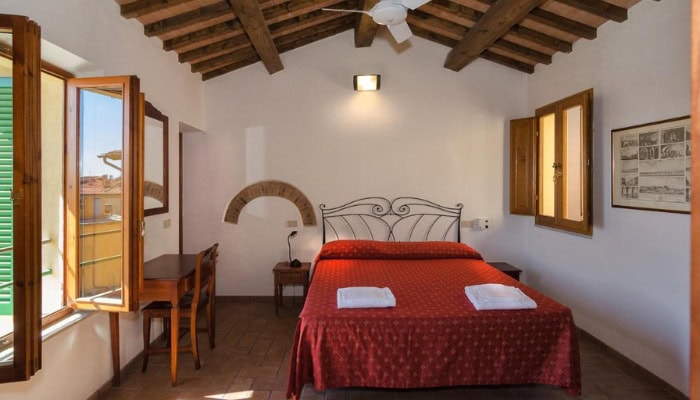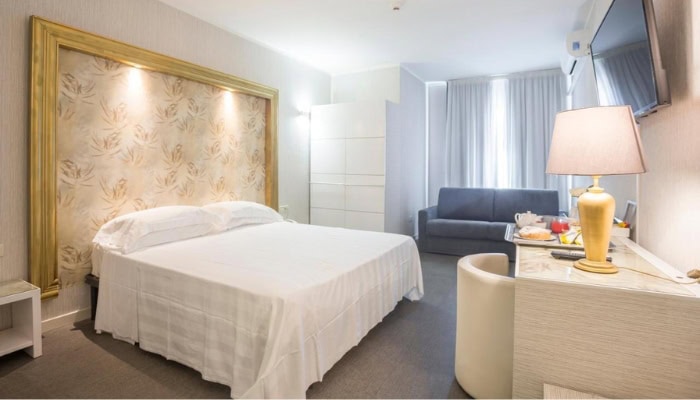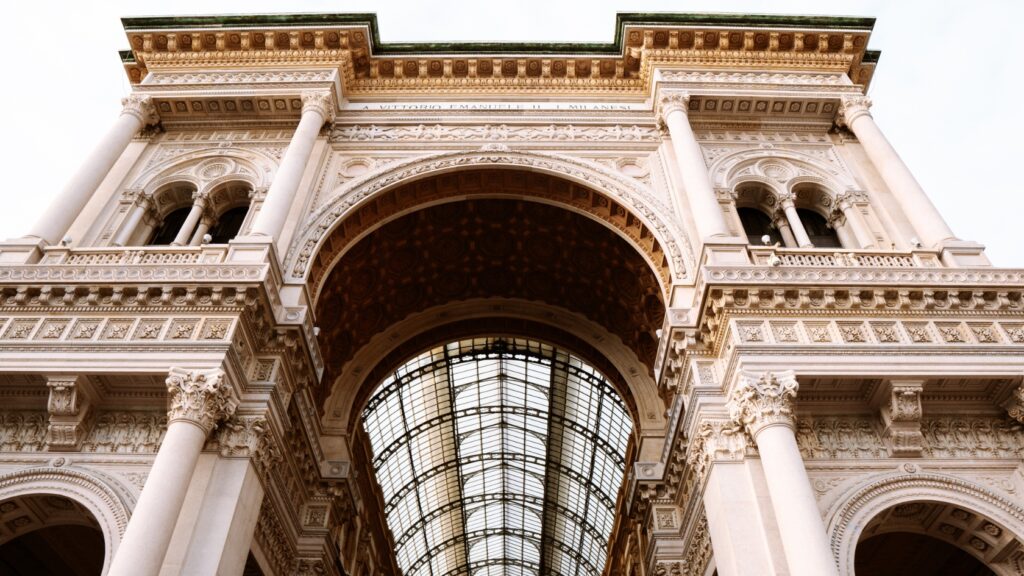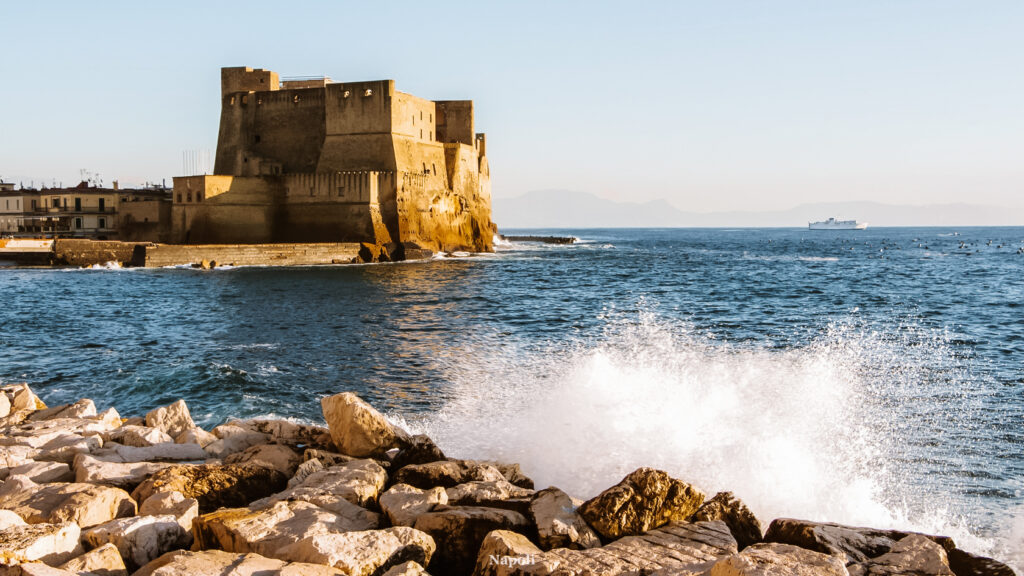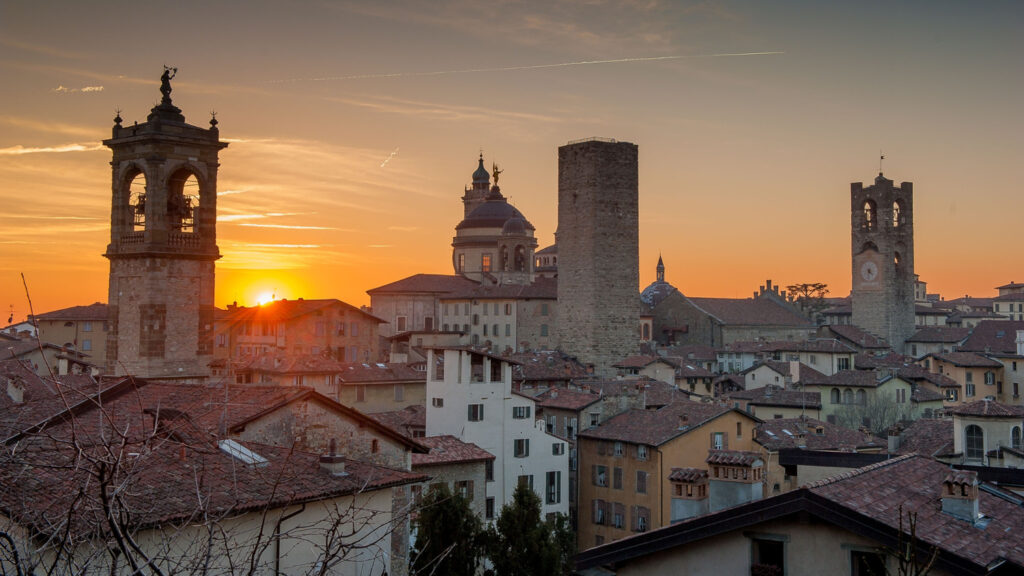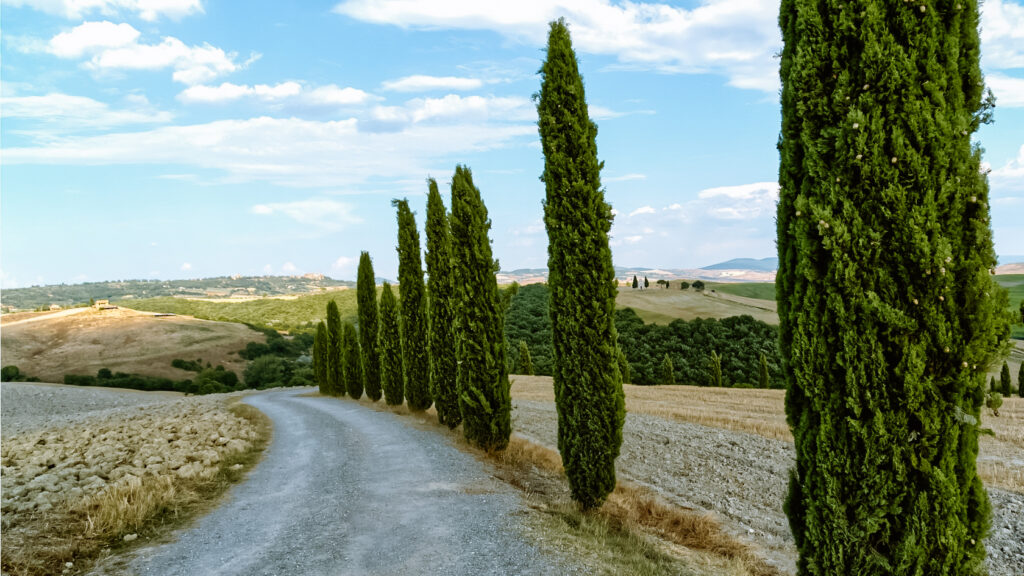Pisa in Italy is full of beautiful places just like the whole of Tuscany. Check out the complete guide for tips on things to do in Pisa and other practical information on transport, accommodation, prices, food and other useful tips.
- Pisa in Italy
- Things to do in Pisa: Best places to see
- 1. Piazza dei Miracoli (Square of Miracles)
- 2. Cathedral of Pisa (Cattedrale di Pisa)
- 3. Leaning Tower of Pisa (Torre pendente)
- 4. Museum dell'Opera del Duomo
- 5. Camposanto monumentale (Campo Santo)
- 6. Baptistery in Pisa
- 7. Sinopie Museum
- 8. Medieval fortifications
- 9. Museo Nazionale di San Matteo
- 10. Botanical Gardens of the University of Pisa
- 11. Piazza dei Cavalieri
- 12. Borgo Stretto a Corso Italia
- 13. Old Town
- 14. Tuttomondo
- 15. Lungarno Promenade
- 16. Palazzo Blu
- 17. Church of Santa Maria della Spina (Chiesa di Santa Maria della Spina)
- 18. Torre della Cittadella
- 19. Basilica of San Piero a Grado
- Pisa beaches and sea
- Pisa, Italy: Things to do in Pisa
- Where to stay in Pisa?
- How to get to Pisa, Italy?
- Pisa food, restaurants and ice cream
- Prices in Pisa
- Pisa, Italy: what is the weather and when to visit?
- Pisa practical information
- Things to see and do in Pisa – Map
- The best booking resources for visiting Pisa
- More information about Italy
- Summary: Things to do in Pisa, Italy
Pisa in Italy
Pisa is located in the north-west of Tuscany. Just 10 km from the Ligurian Sea and 80 km from Florence. It’s a city of nearly a hundred thousand people, famous for its Miracle Square, Leaning Tower, magnificent cathedral and winding historic streets. It is one of the most beautiful cities in Italy.
You only need 1 day to visit it. But I recommend you to set aside more time, because you can spend the next days in the surroundings of Pisa, which are also definitely worth it (we’ll show you some tips at the end of the guide).
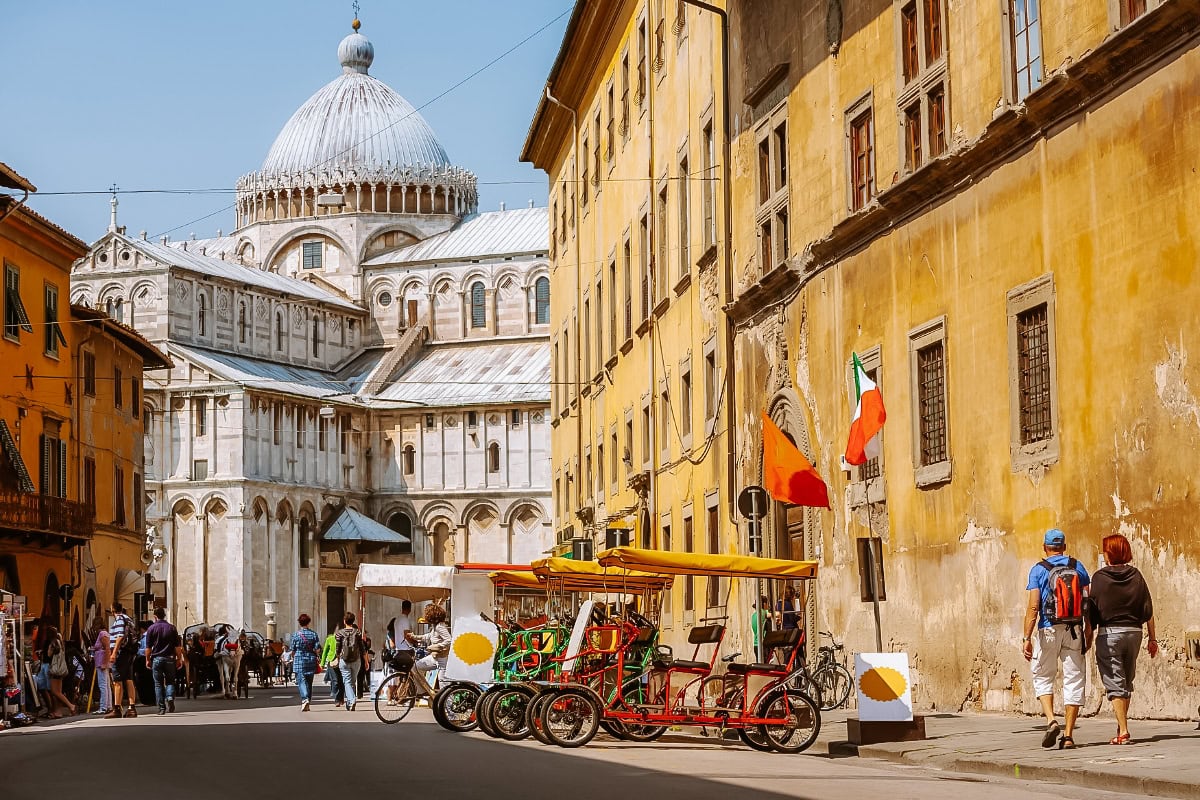
Things to do in Pisa: Best places to see
When you say Pisa, most of us probably think of the Leaning Tower. But this is not the only sight to visit in Pisa.
Come and see the interesting places to see in Pisa:
1. Piazza dei Miracoli (Square of Miracles)
Piazza dei Miracoli is one of the best places to visit in Pisa. It is the exact spot where the world-famous Leaning Tower of Pisa also stands.
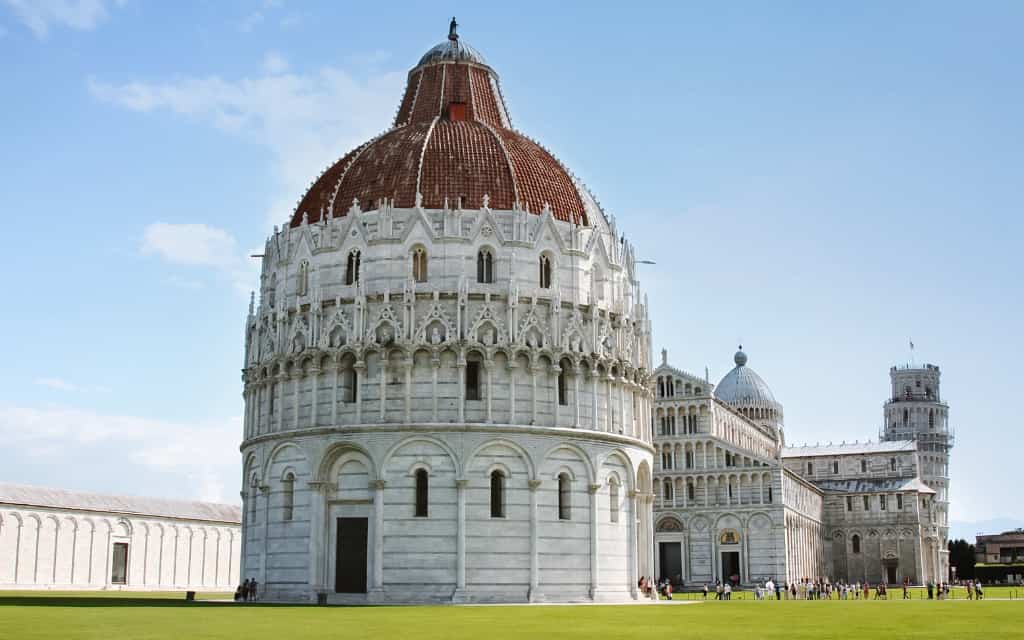
The main entrance to the Piazza dei Miracoli is the Porta Nuova (New Gate) from 1562, which is part of the medieval fortifications. There are many stalls in front of the gate, which will tell you that you are definitely going in the right direction.
You go through the entrance gate (you don’t pay anything yet) and you can see the Baptistery, the Cathedral of Pisa on your left and the Leaning Tower behind it. Behind the cathedral on the left is the Camposanto monumentale cemetery.
The placement is not random. In the Piazza dei Miracoli, the baptistery represents birth, the cathedral represents life and the cemetery represents death.
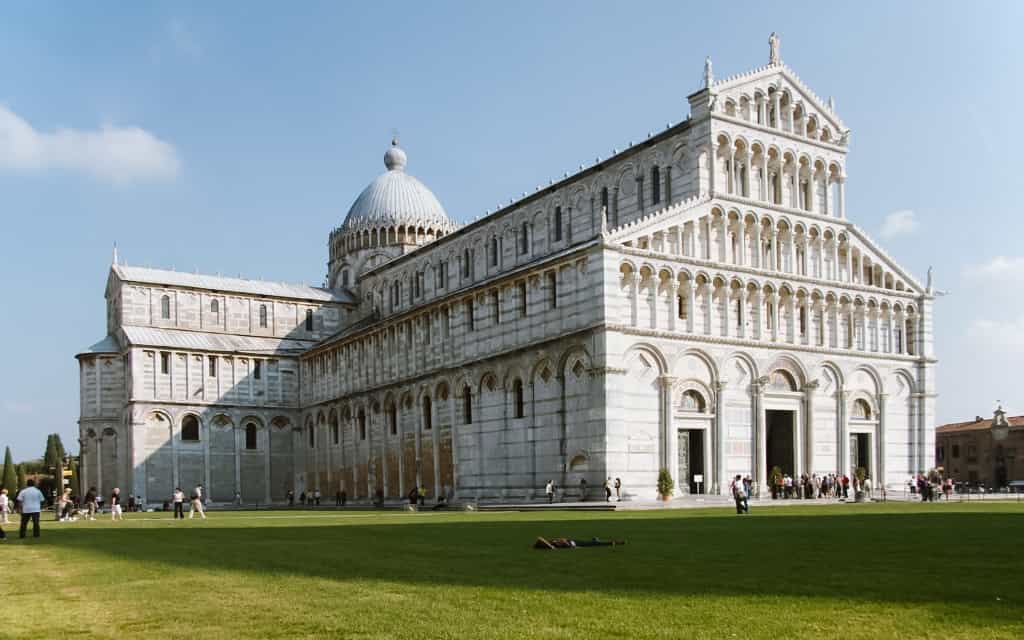
The square is officially called Piazza del Duomo, as in many other Italian cities where the cathedral reigns supreme ( Milan, for example). In 1910, however, the Italian writer Gabrielle d’Annunzio described the square in one of her books as a place full of miracles, and the description took hold so that people nicknamed the square Piazza dei Miracoli (Square of Miracles). Today it is a UNESCO World Heritage Site.
If you plan to visit Pisa during the high season, it’s best to save Piazza dei Miracoli for later in the afternoon, when there are fewer tourists.
Admission to the square and the cathedral is free. If you are planning to visit the Leaning Tower, the entrance fee is €20. The entrance fee for all of this is 27 €. Below we will tell you more about each place.
2. Cathedral of Pisa (Cattedrale di Pisa)
According to the Pisans, the Romanesque Cathedral of the Assumption in Pisa (Cattedrale di Pisa) was to become the most beautiful and largest cathedral in the world. The rulers of the Pisan Republic wanted to show their power and wealth. The largest cathedral is the Duomo in Milan, but its beauty cannot be denied. It is magnificent and often more eye-catching than the Leaning Tower behind it.
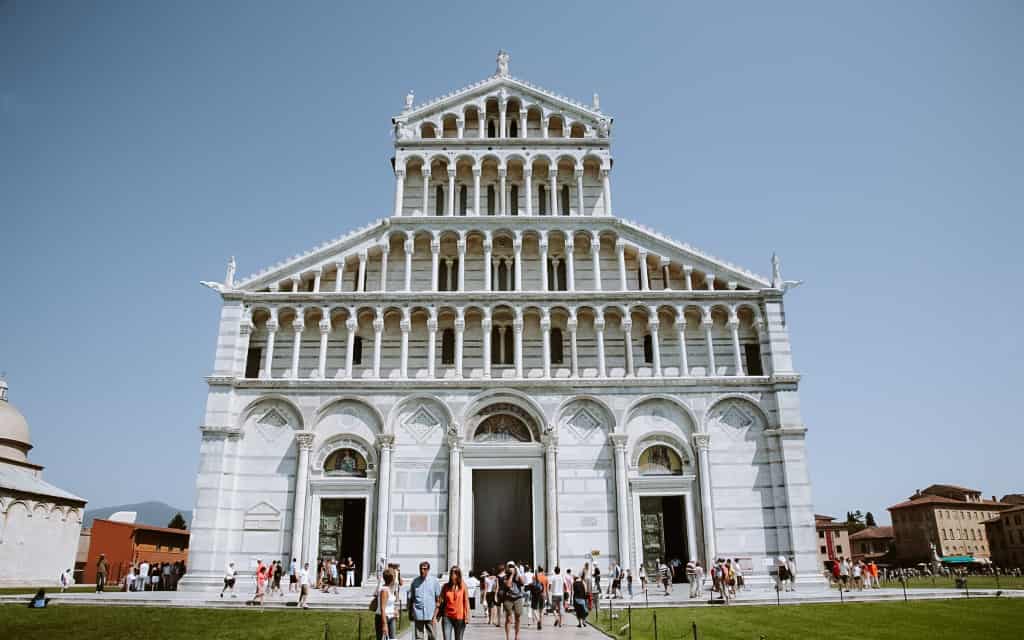
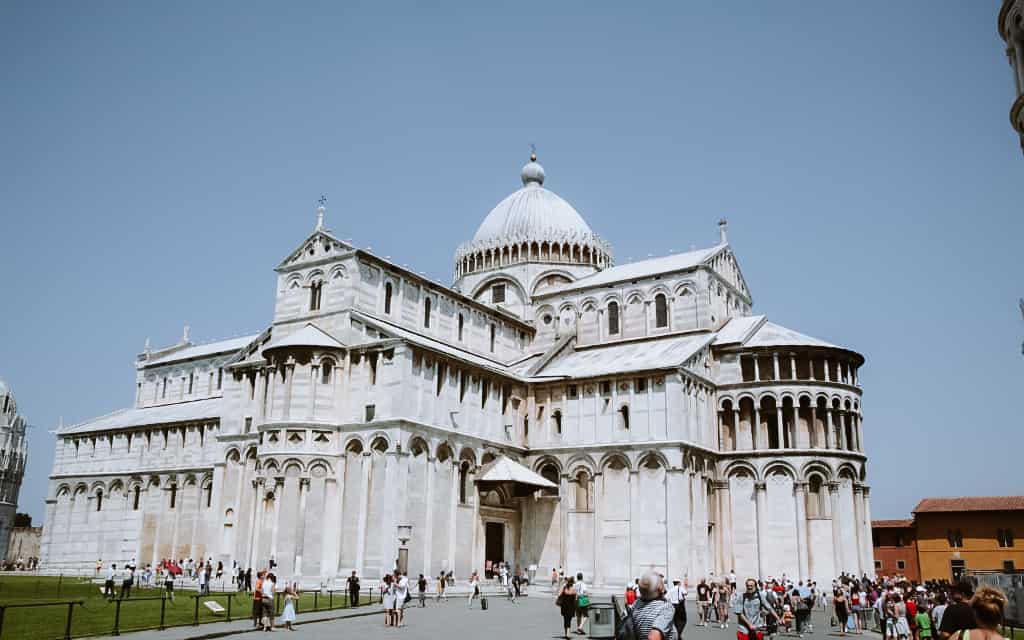
The construction of the cathedral began in 11th century and is thus the oldest building in the Square of Miracles. The cathedral has been restored and enlarged several times over the centuries. In 16th century, a fire broke out here, destroying the roof and a large part of the medieval frescoes. That is why most of the frescoes inside the cathedral are from the Renaissance period.
The huge mosaic of Christ on the apse and the six-sided pulpit by Giovanni Pisano with New Testament themes, which inspired Michelangelo, survived the fire. The tomb of Saint Rainerius, patron saint of the town and its visitors, and the magnificent coffered ceiling are also worth seeing.
Pisa Cathedral was also the model for the cathedrals in Florence and Siena, other cities in Tuscany not far from Pisa.

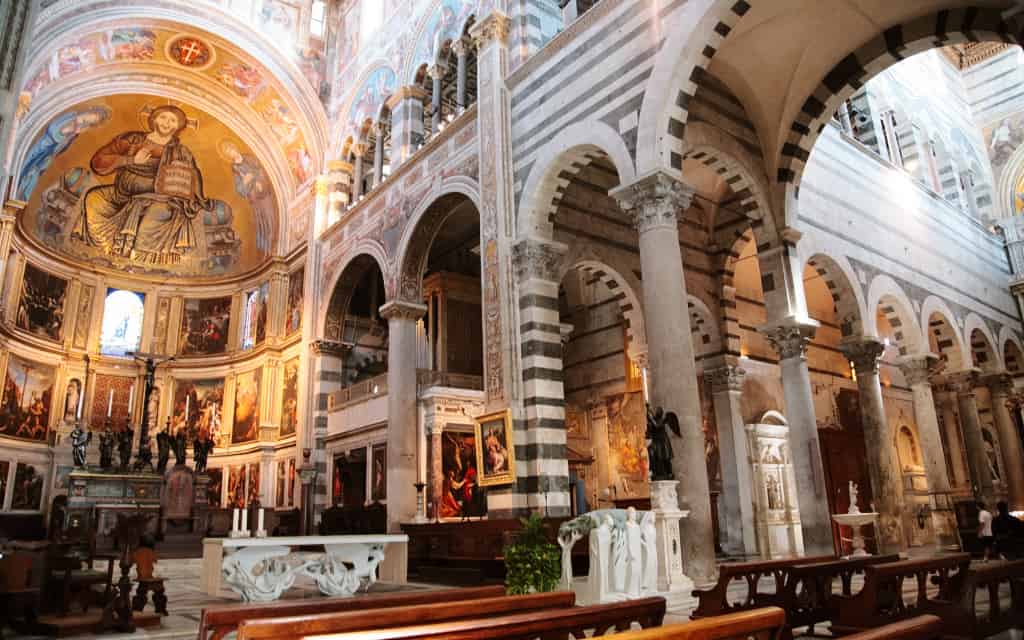
Pisa Cathedral entrance and opening hours
The entrance to the cathedral is opposite the baptistery and consists of 3 large bronze doors. If you look closely, you can see the stories the doors tell. You enter the cathedral and check in with the worker on your left.
Please note: Admission to the Pisa Cathedral is free, but you must have purchased a ticket for another location within the Square of Miracles complex (such as the entrance to the Leaning Tower). So you need to keep your ticket to get into the cathedral. The cathedral is open daily from 10:00-20:00 (13:00-20:00 on Sundays and public holidays). Book a ticket for the Cathedral and the Leaning Tower.
3. Leaning Tower of Pisa (Torre pendente)
There is no more famous monument in Pisa. The Leaning Tower has become a symbol of the city and attracts millions of visitors every year who want to take a symbolic photo. The Leaning Tower must be on your list of things to do in Pisa.
The Romanesque bell tower is 55.86 m high on the shortest side and up to 56.67 m on the longest side and consists of 8 floors. The tower took 200 years to complete, but the work itself took only 20 years.
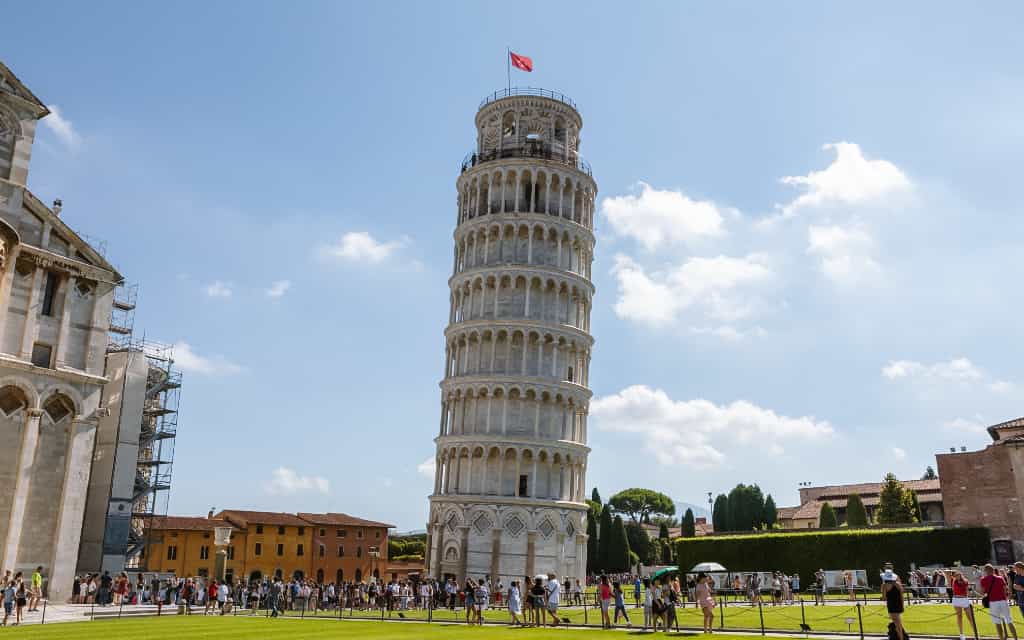
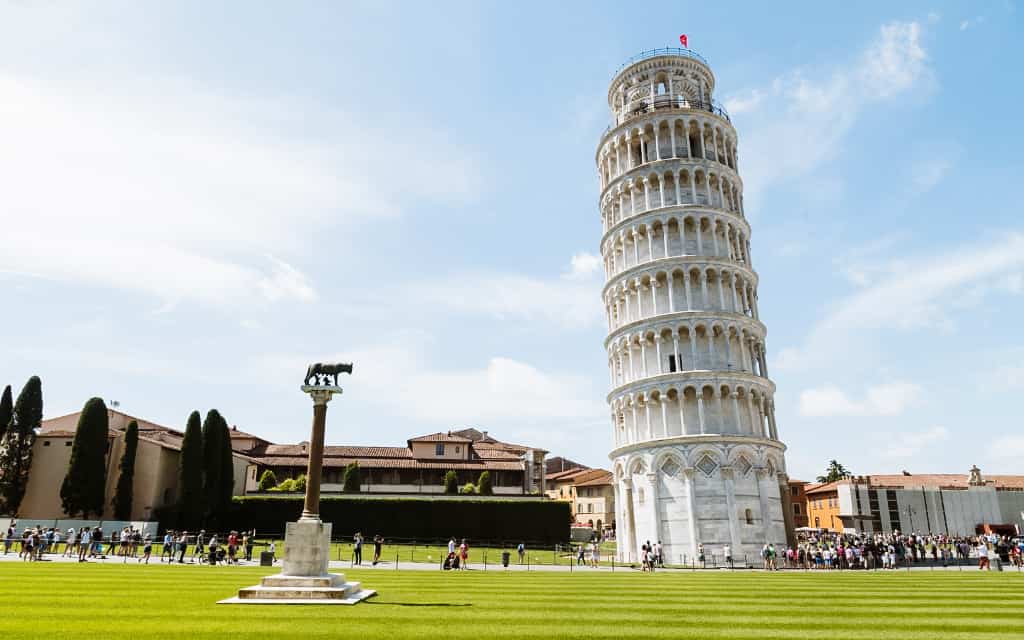
Why is the Leaning Tower of Pisa Leaning?
This is due to the unstable floor containing a large amount of sand and the architect’s error in not taking the floor into account. This caused the Leaning Tower of Pisa to start tilting during the construction process and the construction was suspended. In 1990, the angle of inclination was even 5.4 degrees and the Leaning Tower was in danger of collapsing.
The tower was closed and in 1993 work began on securing the structure using drills to remove sandy soil and ropes to secure the tower, which partially stabilized the Leaning Tower and “straightened” it by 0.5 degrees.
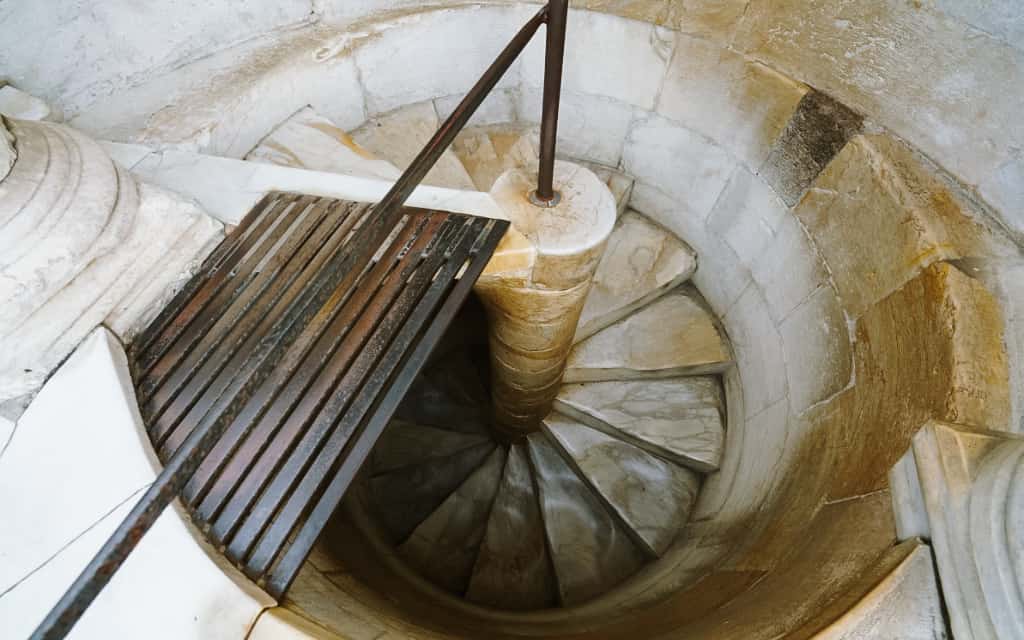
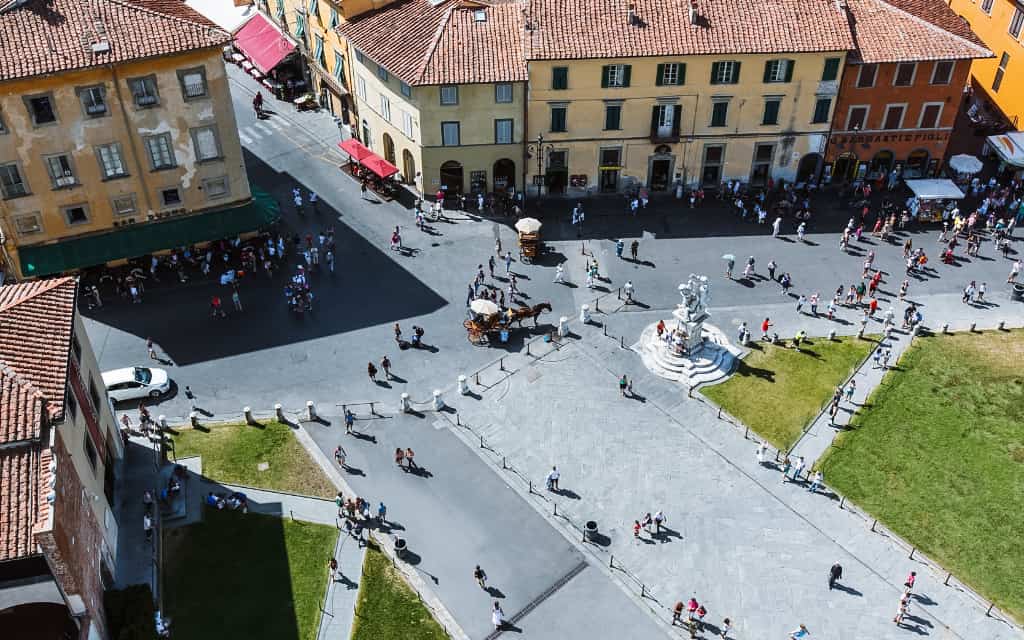
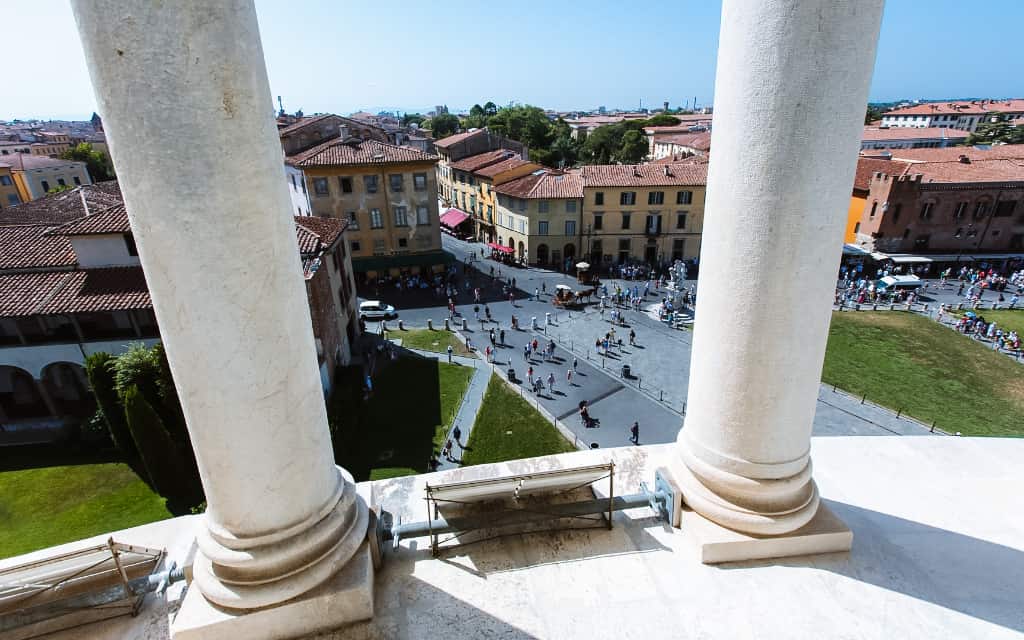
Leaning Tower of Pisa tickets, admission and opening hours
Admission to the Leaning Tower is €20 for everyone over the age of 8.
Due to the influx of tourists, you must book your ticket in advance for a specific time. With this, you will then arrive at the tower, where you will see a worker letting in a small group of visitors every 15 minutes.
For safety reasons, only children over the age of 8 can enter the tower and children under 18 must be accompanied by an adult.
The tower is open daily from 9:00-20:00.
4. Museum dell’Opera del Duomo
The Museo dell’Opera del Duomo displays the rich embroideries, paintings, decorations, busts and other art from the cathedral and the Piazza del Miracles to protect against air pollution. The most famous bust is that of Julius Caesar, which faithfully represents what Caesar looked like, as it was made during his lifetime or shortly afterwards.
The museum is located on the right side of the Leaning Tower. Admission to the museum is 7 €.
Hotels in Pisa 😴
5. Camposanto monumentale (Campo Santo)
The Camposante monumentale is a place on the left side of the cathedral that has been used for centuries as a cemetery for the elite of Pisa. It has 3 chapels and is made of shiny white marble. Inside, it hides beautiful Roman statues and frescoes, which were badly damaged during the bombing of the Second World War. World War II. Since then, sensitive restoration work has been underway.
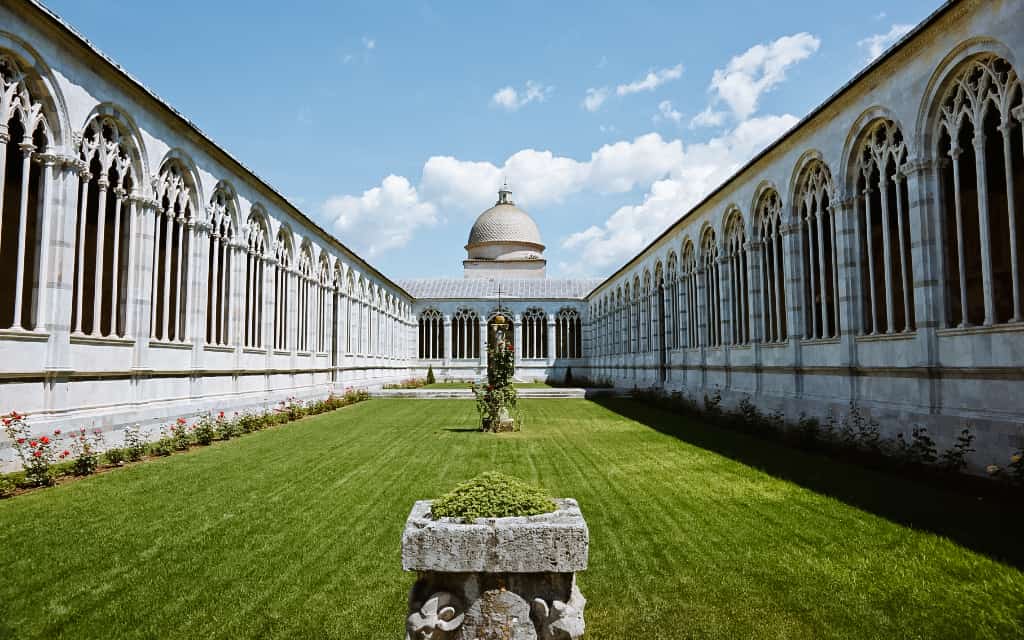
Camposanto monumentale is called Campo Santo, which literally means Holy Field. According to legend, it was built around the sacred soil of Golgotha, which the Pisans brought back from the Third Crusade. The body is said to rot in the sacred soil of Campo Santo for only 24 hours after burial. Admission to Campo Santo is €7.
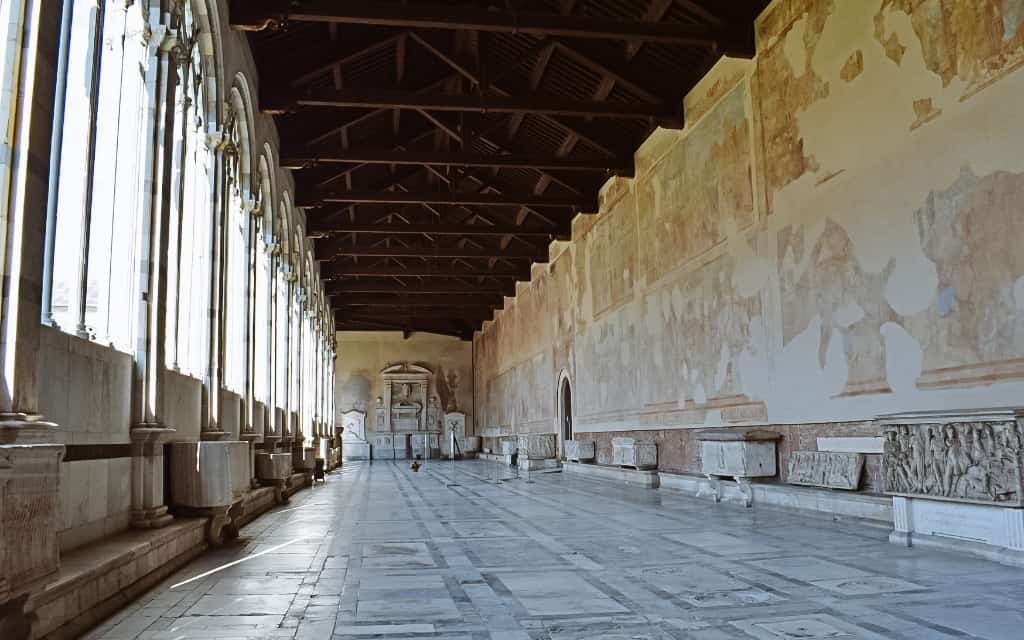
6. Baptistery in Pisa
The Baptistery of Pisa (Battistero di San Giovanni) is located at the very beginning of the square and will literally amaze you with its ornaments, decorations and statues. At 54 m high and 34 m wide, it is the largest Baptistery in Italy.
Do you know why baptisteries are so big? So the bishops can baptize all the children at once. The local baptistery was built in the 11th-14th century and replaced the original baptistery.
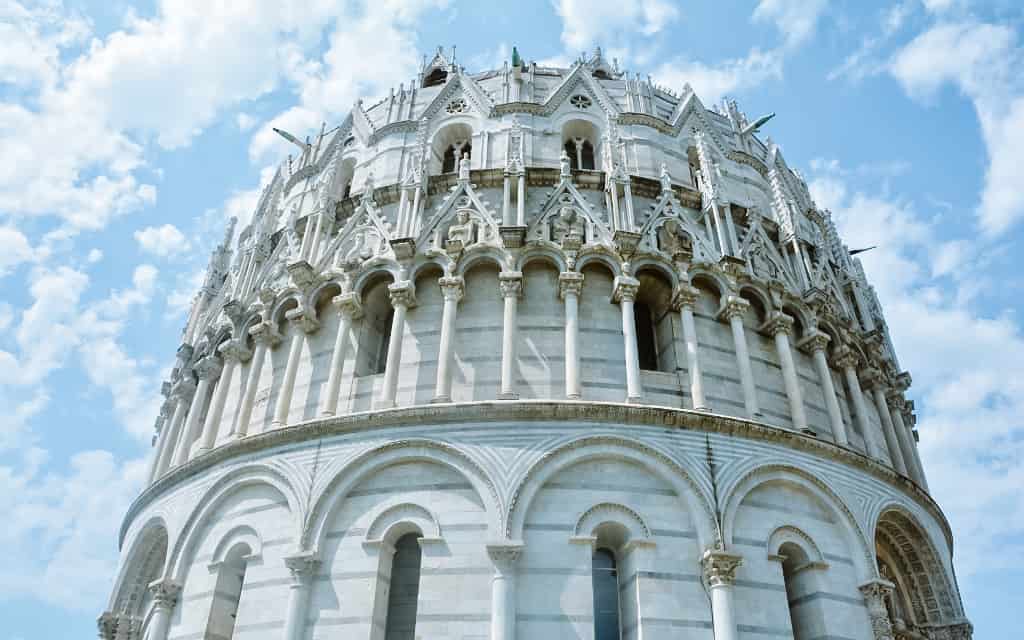
Like the cathedral and the Leaning Tower, it stands on an unstable floor, so it leans slightly towards the cathedral.
If you look inside the Baptistery, you will see an octagonal baptismal font in the middle. The stairs take you to the upper gallery, which has an unusual echo thanks to its double dome. Admission to the baptistery is 7 €.
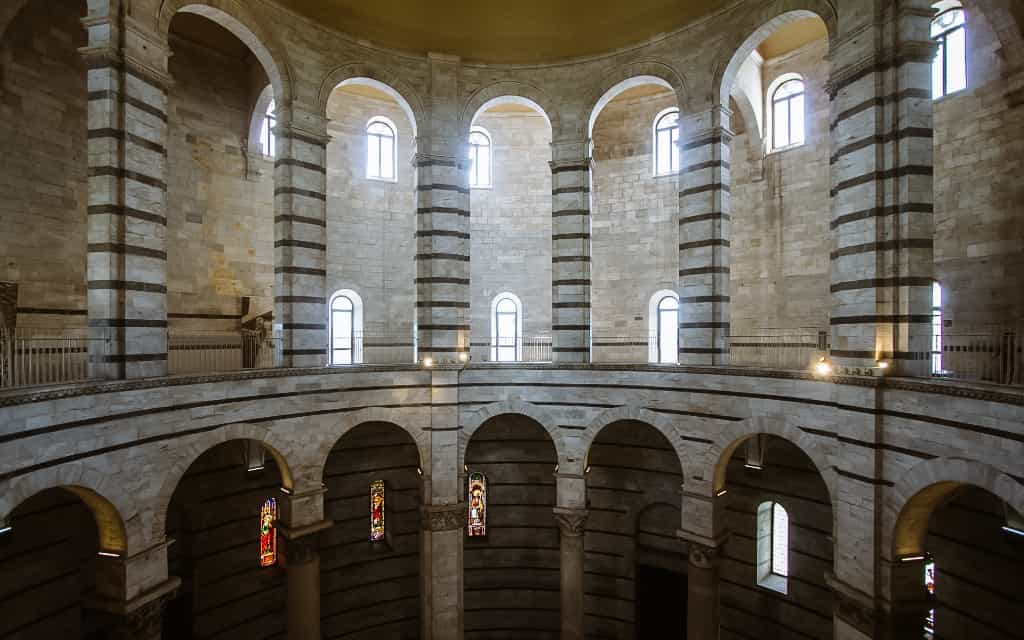
7. Sinopie Museum
The Sinopia Museum is housed in a red-orange building on the right-hand side of Piazza del Duomo. Here you will find preparatory drawings and rough sketches that served as a model for the frescoes in the Camposanto monumentale. Admission to the Sinopia Museum is 7 €.
☞ Detailed itinerary for a 5-7 day roadtrip in Tuscany.
8. Medieval fortifications
If you walk from the baptistery towards the cemetery and follow the walls to the left, you will reach one of the entrances to the medieval fortifications with the 12th century Torre di Santa Maria. The walls have a total length of 3 km and the entrance costs about 3 € (pay on the spot).
Why come here? Only a handful of tourists come here and there are beautiful views of the whole square.
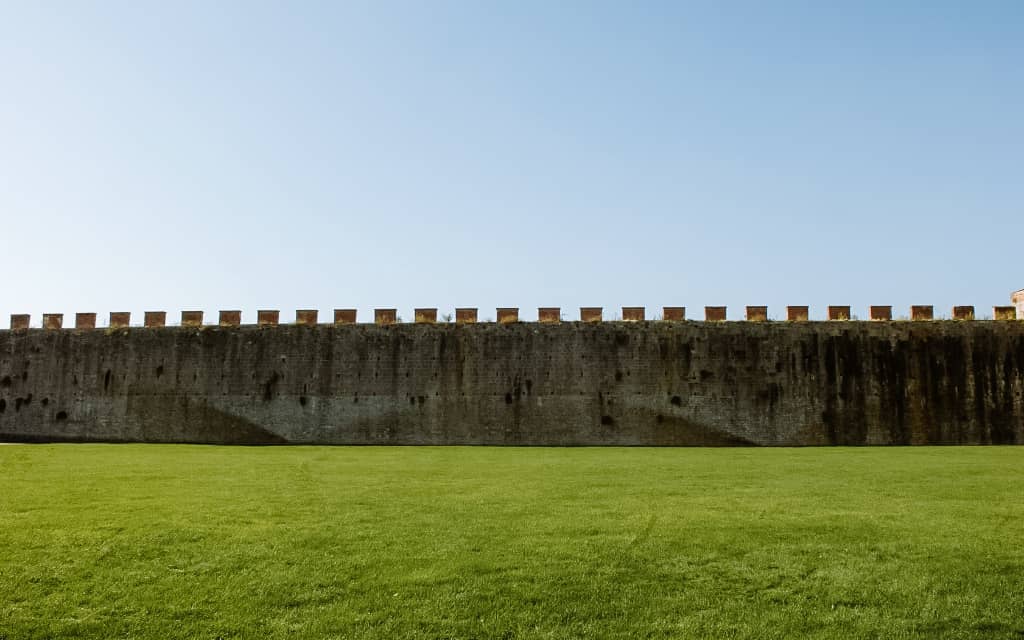
9. Museo Nazionale di San Matteo
Do you love art? Then you shouldn’t miss the Museo Nazionale di San Matteo, which includes medieval art, altarpieces and other interesting works from the 12th -15. century. The museum is housed in a former convent building in Piazza San Matteo. Admission is 5 € (reduced 2 €).
You can get in at specific times: from Tuesday to Saturday only at 9.00, 11.30, 15.30, 17.30 and on Sundays and public holidays at 9.00 and 11.30.
10. Botanical Gardens of the University of Pisa
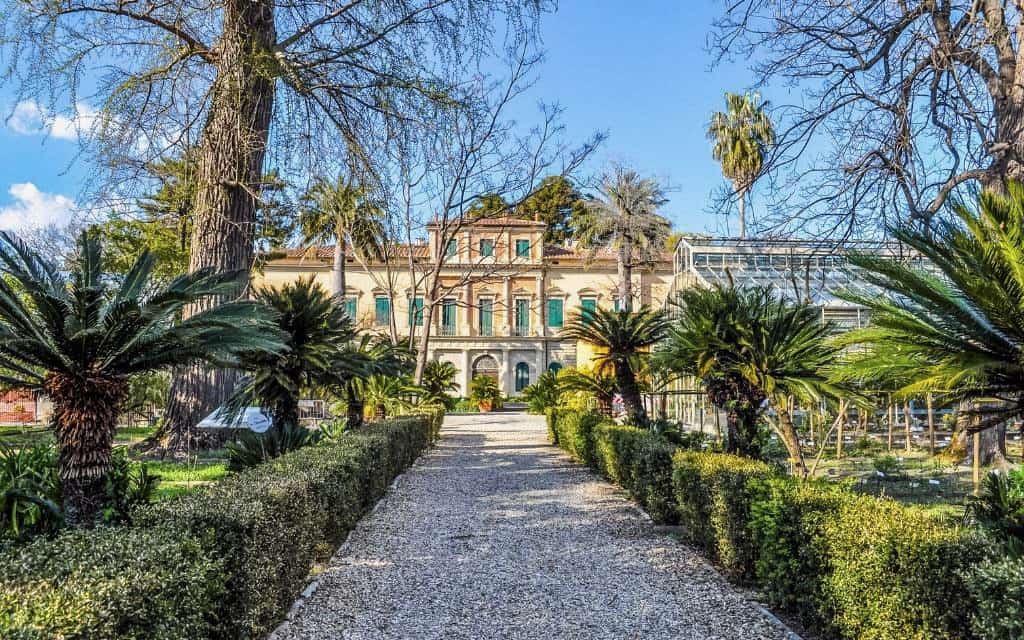
Botanical gardens from 16th century are located in the historic centre of the city and are one of the oldest academic botanical gardens in the world. Here you will find an arboretum, aquatic and medicinal plants and plenty of trees where you can take a break from the scorching sun of the city during the summer months. The old botanical school with its facade decorated with shells is worth seeing.
The garden is open from 8:30-17:00. Admission is 4 €, reduced admission 2 € for children 6-12 years old and free for children under 6 years old and persons with a Disabled Persons Card including an escort.
11. Piazza dei Cavalieri
Piazza dei Cavalieri, or Knights’ Square, was the seat of government and a centre of political art in the Middle Ages. This has changed over the centuries and today it is instead the imaginary academic centre of the city. Piazza dei Cavalieri is decorated with several beautiful buildings and a church.
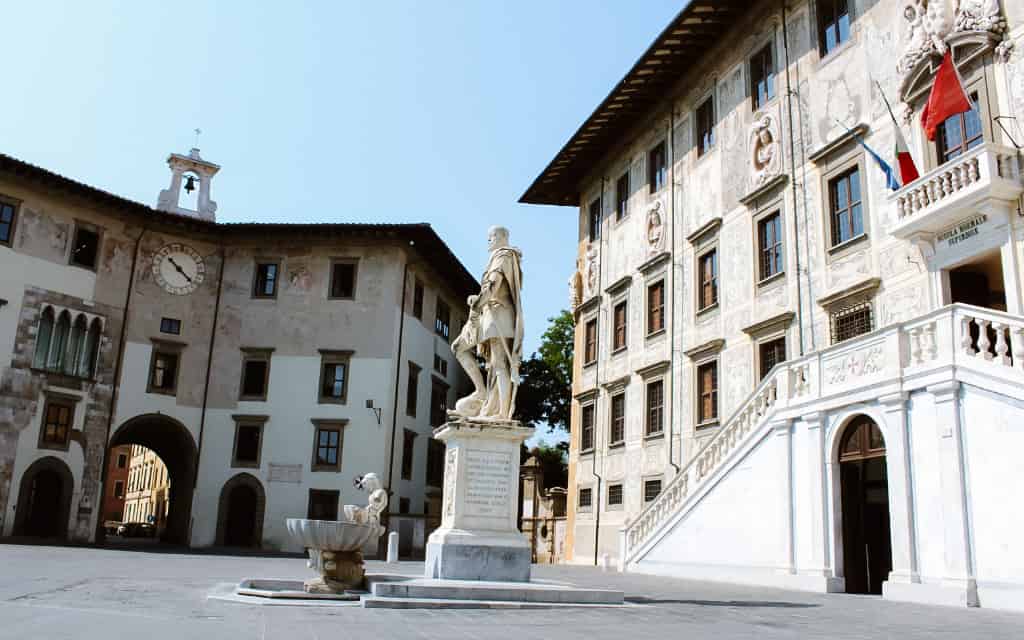
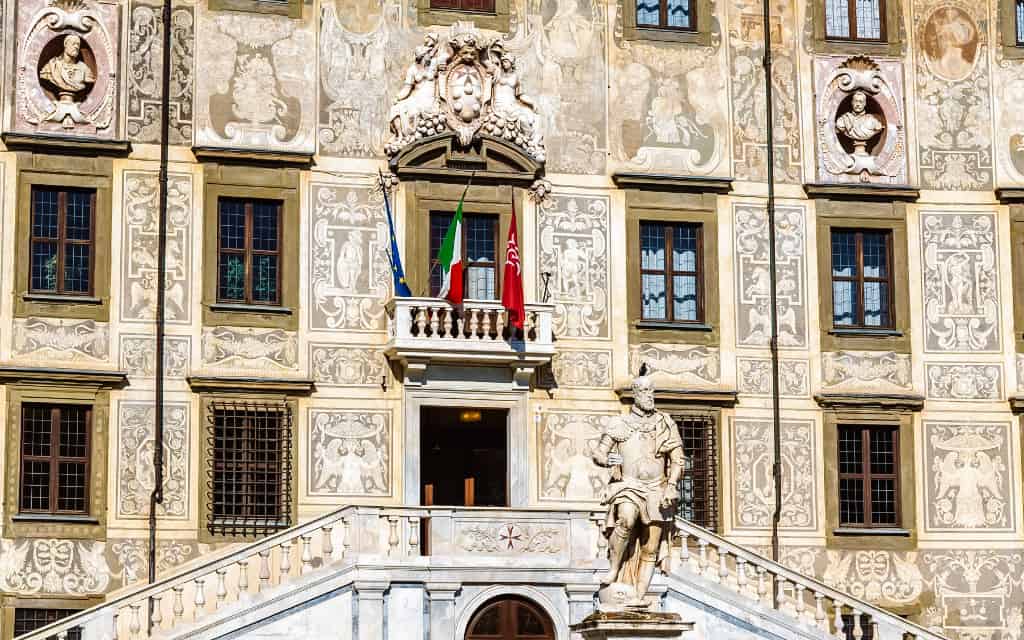
At first glance you will be struck by the magnificent sgraffito and busts on the Palazzo della Carovana, home to the prestigious University of Pisa – the Scuola Normale Superiore, founded by Napoleon in the 18th century (you can find the school’s double in Paris). Sgraffito is a mural painting technique typical of the Renaissance. The patterns are created by scraping two different coloured plasters.
To the right of the Palazzo della Carovana is the Church of San Stefano and to the left is the Palazzo dell’Orologio, named after the great clock.
Piazza dei Cavalieri is named after the Knights of St. Stephen, who were based here from the 16th century. You will see their red and white symbol directly on the buildings.
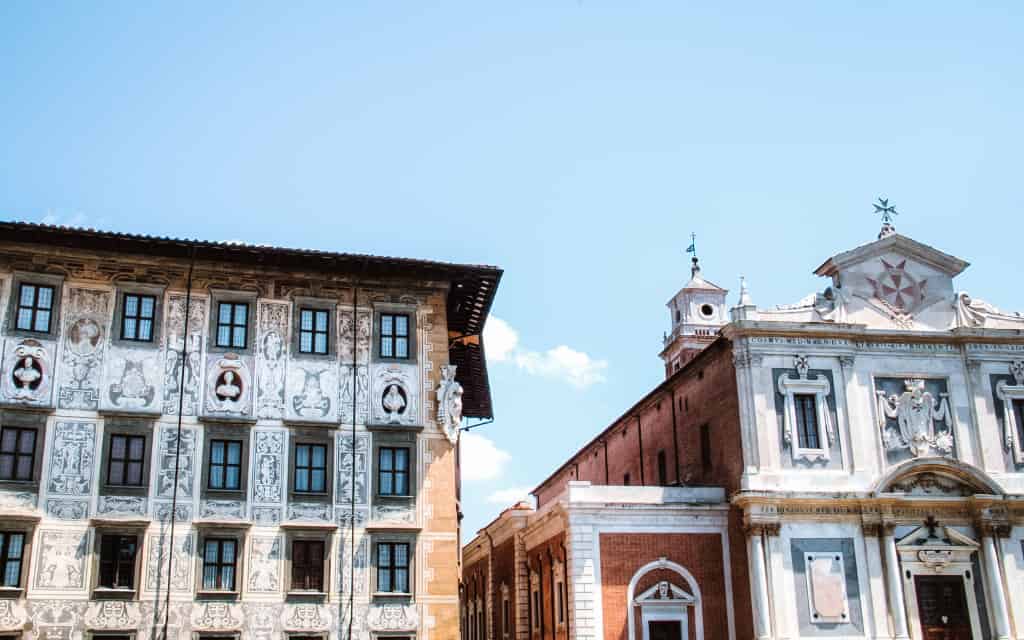
12. Borgo Stretto a Corso Italia
Where to go shopping in Pisa? Borgo Stretto is a medieval street full of cafés and shops. It’s alive here. You will reach the river, where you will cross the Ponte di Mezzo bridge and reach another famous street, Corso Italia. A place full of shops and street food.
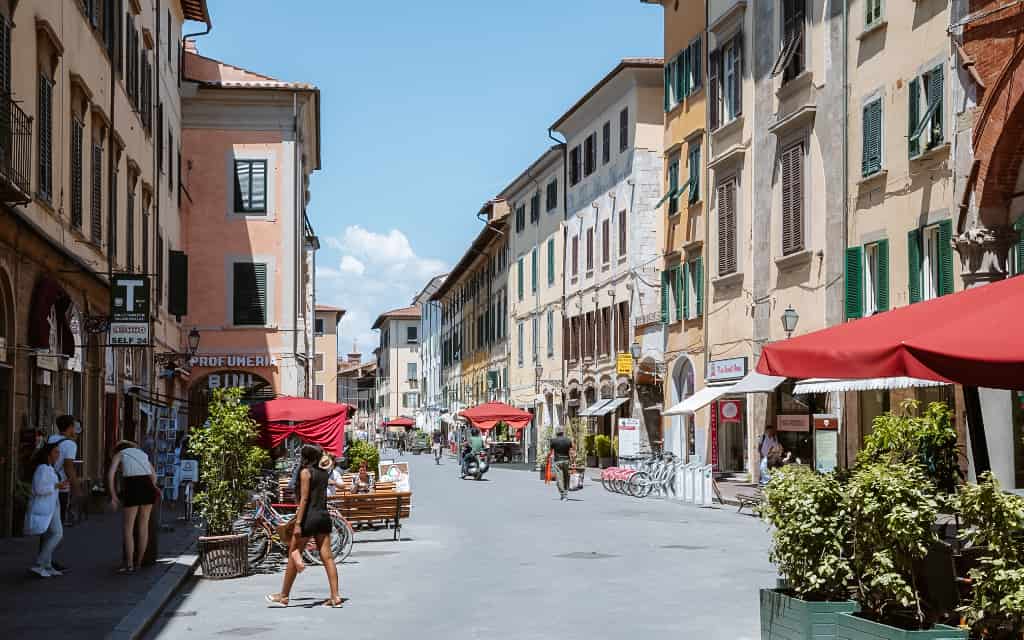
Corso Italia takes you to the spacious Piazza Vittorio Emanuele II, with a statue of Vittorio Emanuele II in the centre. Not far from here, on one of the walls of the church, you will see Tuttomondo (see below).
If you walk from the train station (or airport) towards the Piazza del Fuego, you will first walk along Corso Italia and then Borgo Stretto.
13. Old Town
The streets of the old town are a joy to explore. Just wander around and you will discover hidden corners and authentic Pisan life.
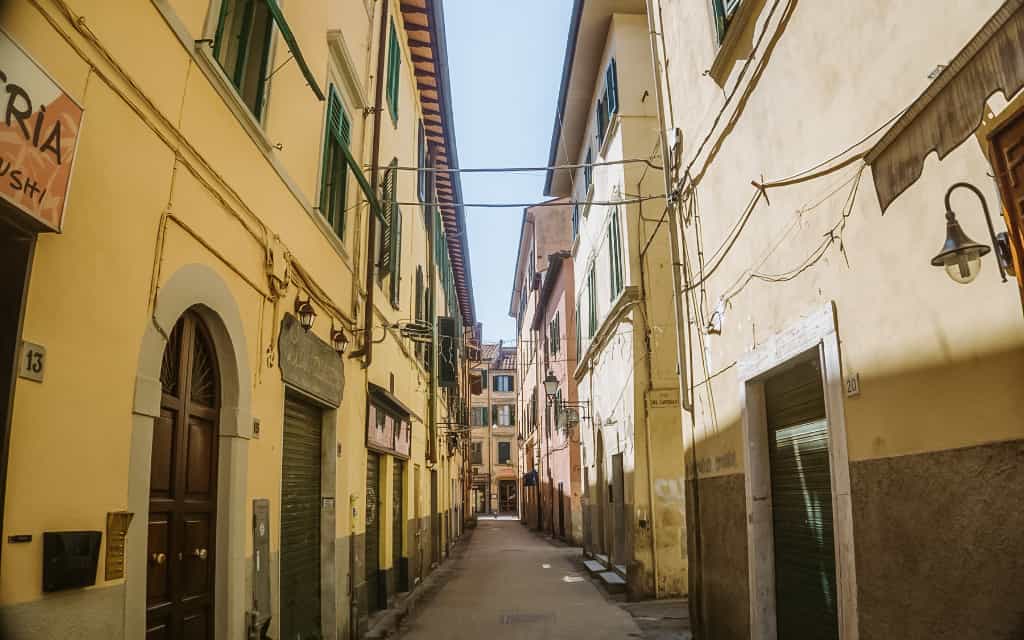
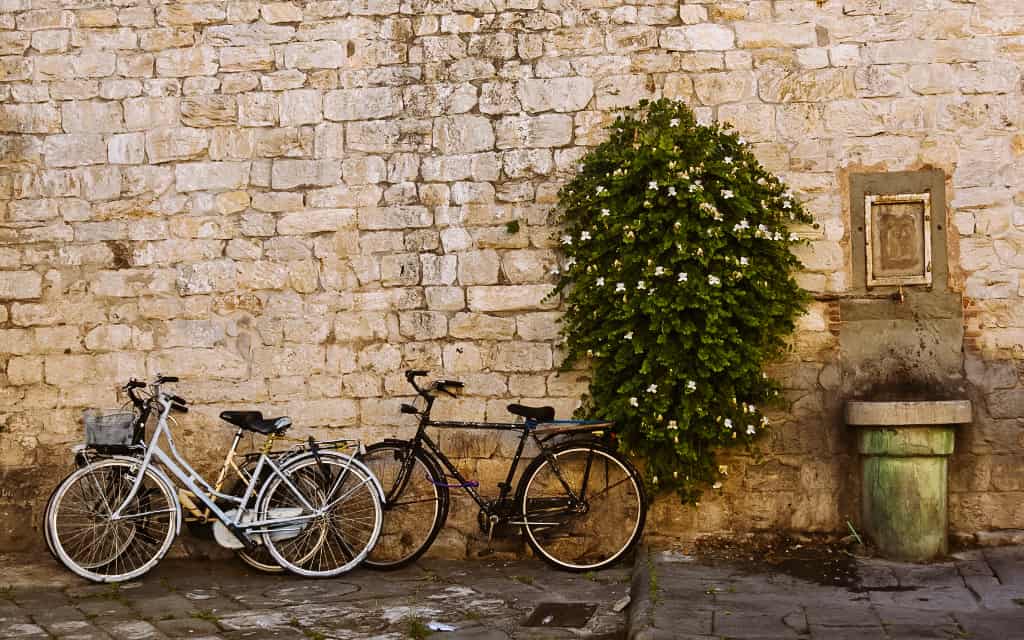
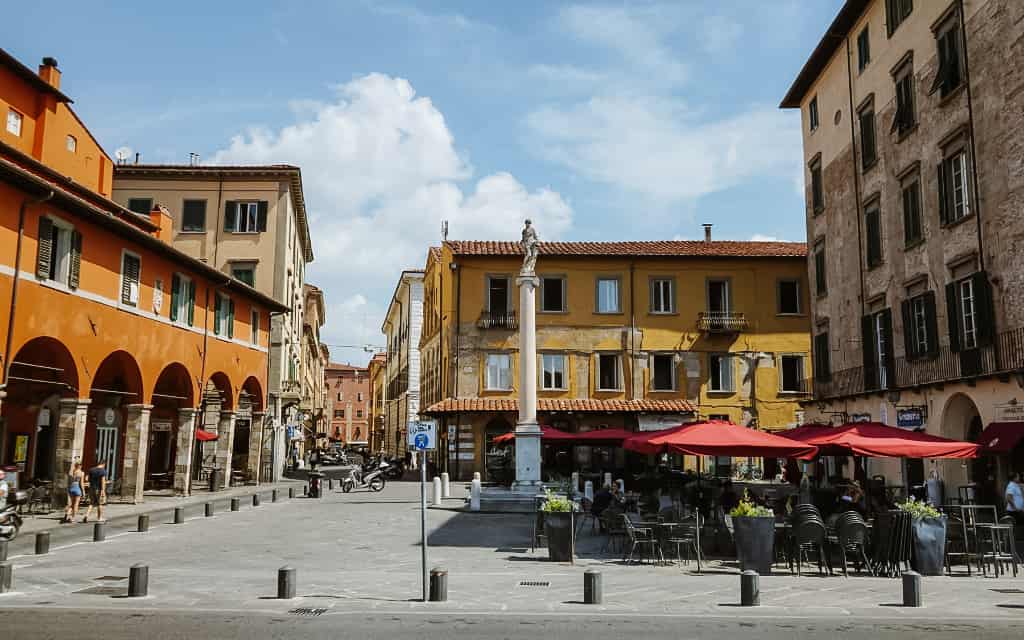
14. Tuttomondo
Tuttomondo is a mural by American artist Keith Haring, who originally came to the city to visit a friend. During his visit, he saw the church wall destroyed by World War II and decided to restore and paint it.
Tuttomondo is a fresh piece of street art and a perfect contrast to the rest of Pisa’s historic core. The painting consists of 30 figures in different positions and colours, representing peace and vitality. Tuttomondo is surrounded by a glass wall.
15. Lungarno Promenade
The promenade is one of the top places to visit in Pisa. And you can’t avoid it when walking through the historic city centre. The promenade lines the banks of the Arno River, which runs through the city (and Florence). The water reflects the surrounding historic homes and palaces.
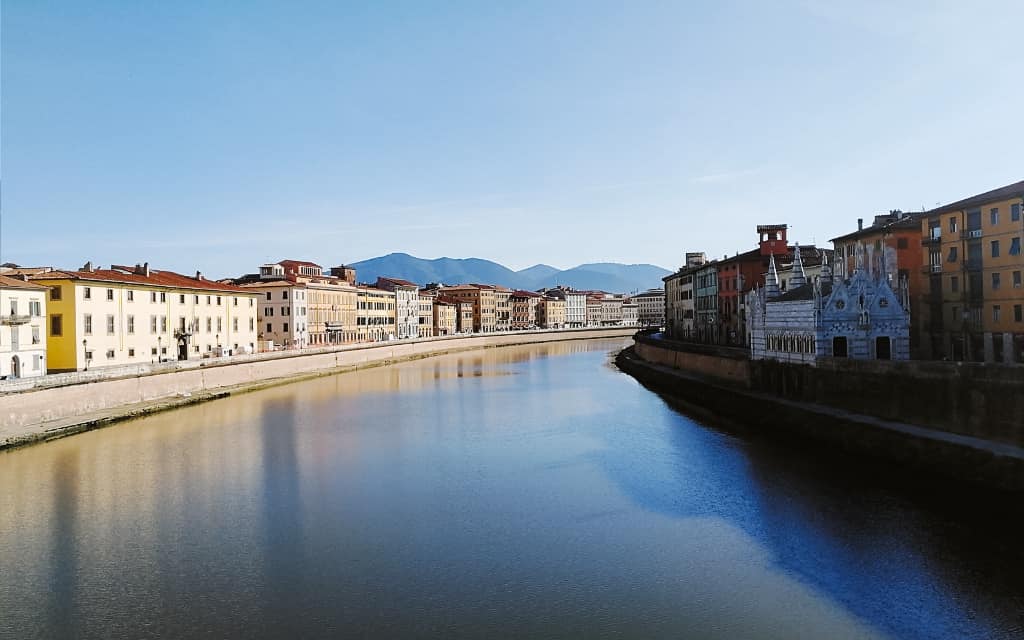
16. Palazzo Blu
Palazzo Blu is right on the riverbank. You can easily recognize it by its blue color. Inside is a collection of fine art by artists from Pisa from the 14th. to 20th century. The permanent collection is complemented by temporary exhibitions of important artists (Chagall, Miro, Dali and others). On the first floor you can enjoy aristocratic apartments from the 19th century.
Entrance to Palazzo Blu is free. It is open daily from Monday to Friday 10:00-19:00 and on weekends and holidays 10:00-20:00.
☞ Are you planning to explore the whole of Tuscany? We’ve written down our tips, what to visit in Tuscany including a map.
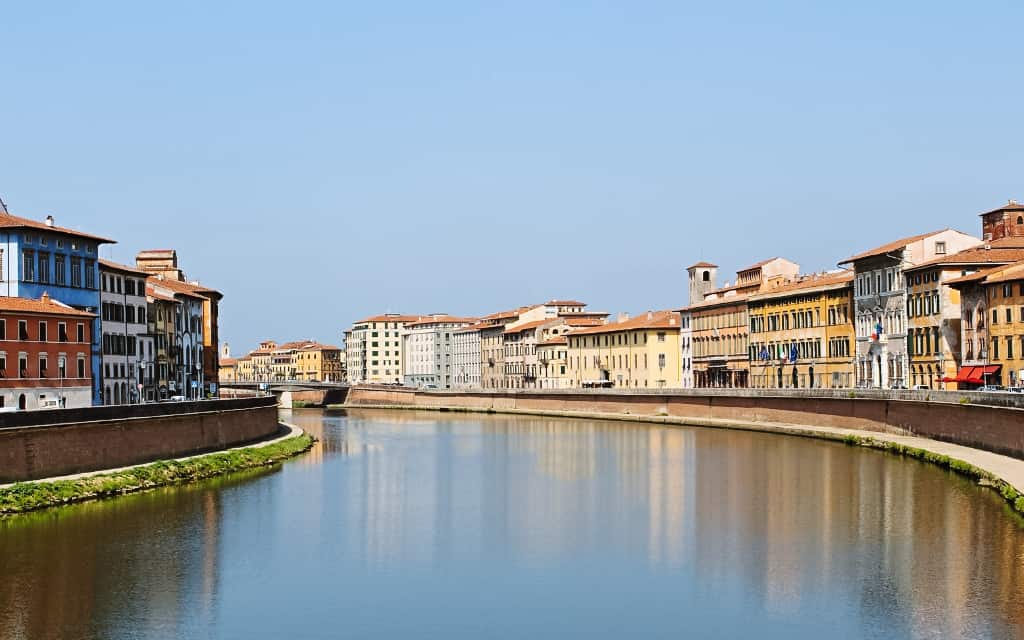
17. Church of Santa Maria della Spina (Chiesa di Santa Maria della Spina)
The small church of Santa Maria della Spina can be found on the left bank of the Arno River, opposite the Museo Nazionale di Pisa (National Museum of Pisa). The church was built in Gothic style and its facade is made of white marble.
Spina means thorny. This is derived from the thorn preserved in the church, which is said to have belonged to the crown of thorns Christ wore on his head at his crucifixion.
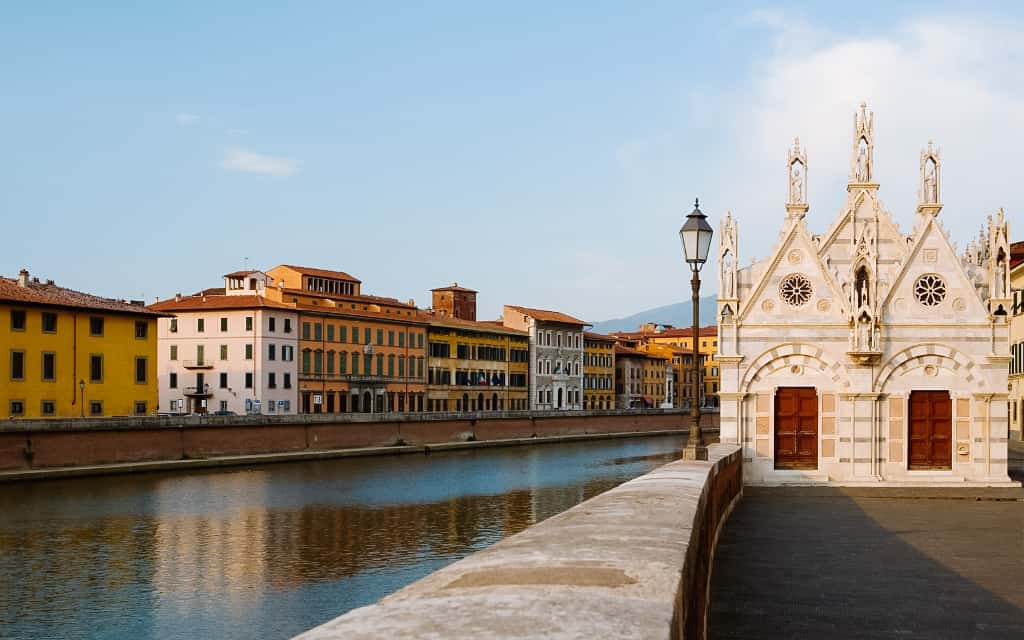
18. Torre della Cittadella
The symbol of the Maritime Republic. The Torre della Cittadella is a historic tower whose purpose was to control the part of Pisa where the river flowed into the sea. The sea was only at Pisa and over the years it has moved up to 10 km from the city. If you would like to learn more about the maritime history of Pisa, don’t miss the Maritime Museum.
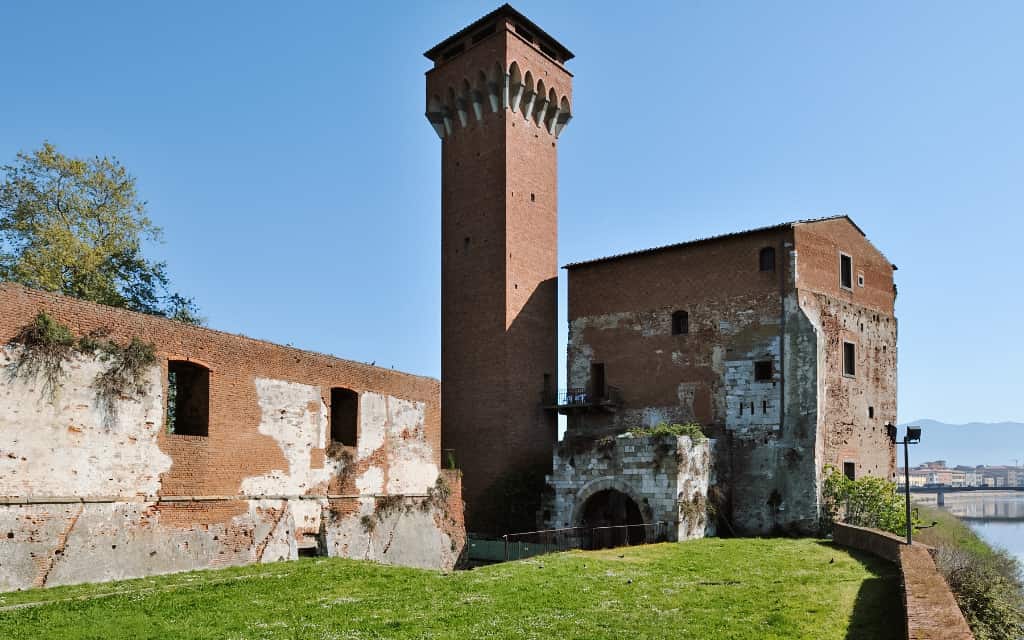
19. Basilica of San Piero a Grado
We move to the outskirts of the town, where you will find the Basilica of San Piero a Grado, built in Pisan Romanesque style. It is a bit overlooked, but definitely worth seeing.
And what’s special about this place? Supposedly, the vanished port of the Pisan Republic once stood here.
You can visit Marina di Pisa on your way to the sea. Just make a small left turn at the roundabout and a little beyond the cemetery you will see the Basilica of San Piero a Grado on your right.
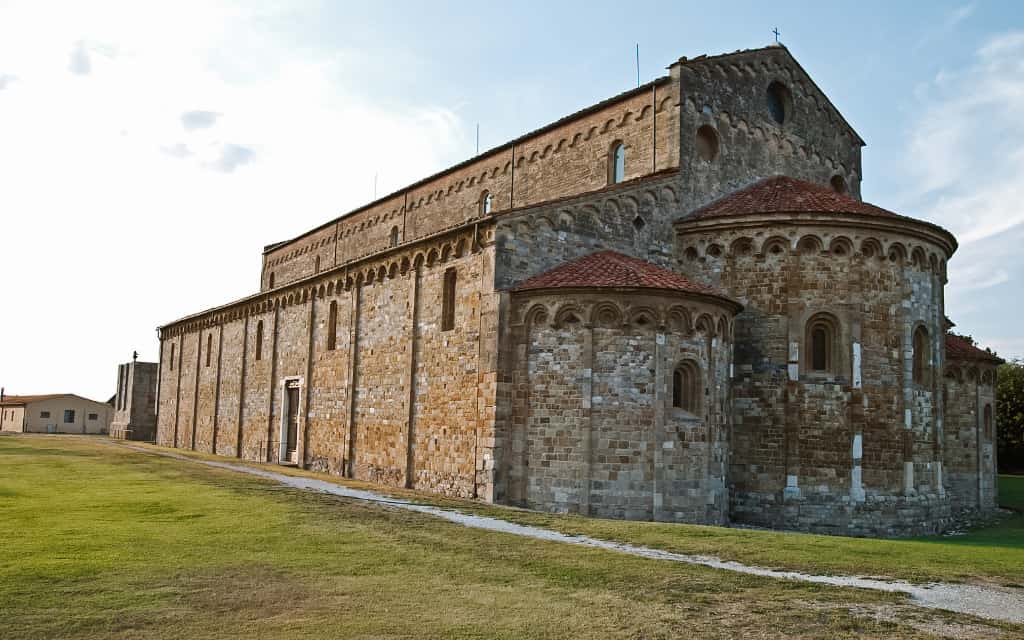
Pisa beaches and sea
The sea is only 10 km away, so it would be a shame not to visit at least one beach. It may not have the most beautiful beaches in Italy, but you won’t be disappointed either.
In addition, some of the beaches around Pisa have been awarded the Blue Flag in recent years. It is awarded to beaches that have met strict standards for cleanliness, service and environmental friendliness.
Marina di Pisa
The nearest seaside town is Marina di Pisa, where you will find sandy and rocky beaches.
The sandy beaches are mostly private for a fee between 10-30€ (you get a sunbed, towel etc) – they are called Stabilimento. There is also an unpaid beach, which consists of smaller white pebbles.
There are buses to Marina di Pisa and the journey takes 30 minutes. The bus stop is a short walk from the beach. To the south of Marina di Pisa is Tirrenia, which also has several public and paid beaches.
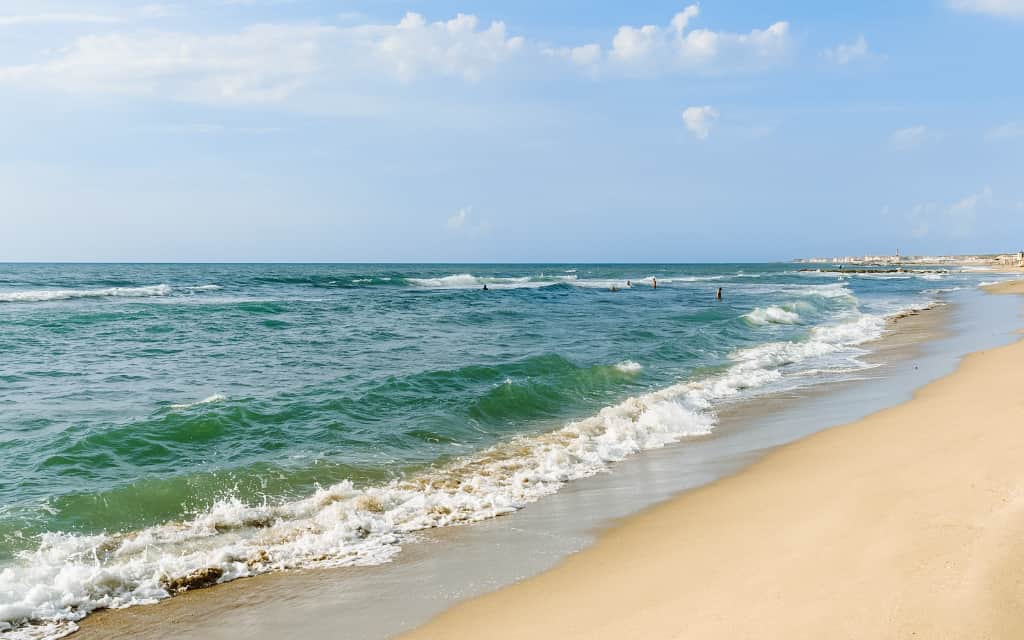
Marina di Torre del Lago
North of Pisa is the long sandy beach of Marina di Torre del Lago, which stretches south to Vecchiano. For us, this is the most beautiful beach around Pisa and everyone who likes wild swimming and sand with fine dunes will love it. The beach is largely public, so don’t expect extra services.
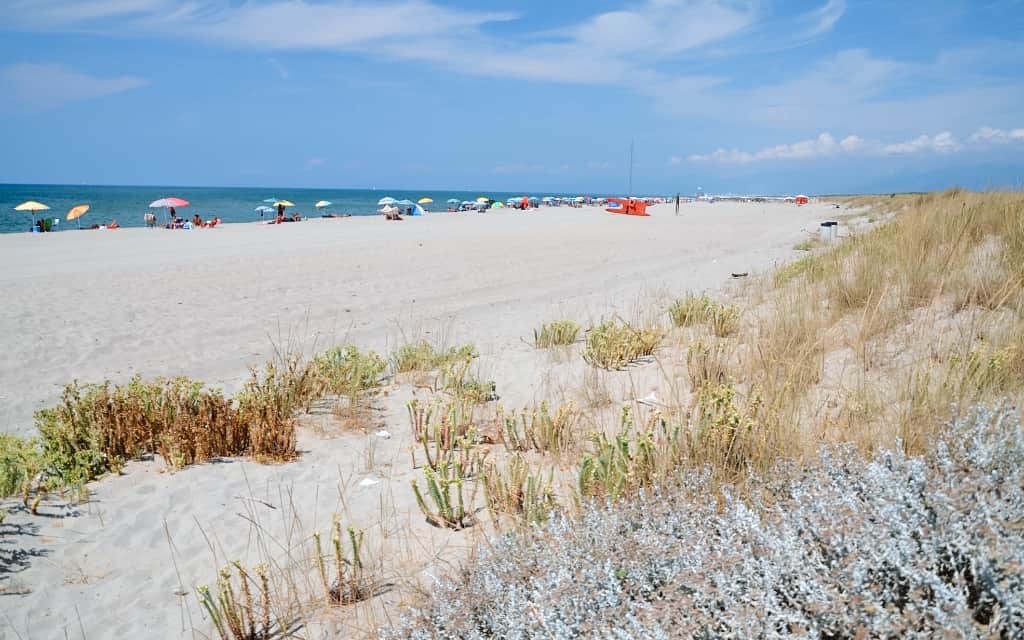
The car park is only 5 minutes from the beach and you can take the train from Pisa in 14 minutes (from the train station it takes about half an hour to the beach). There is plenty of greenery in the area where you can walk freely and cool off under the trees.
You’ll find a beautiful, landscaped, full-service beach in Viareggio, just north of Torre del Lago Puccini.
Hotels in Pisa 😴
Pisa, Italy: Things to do in Pisa
Pisa has an enchanting historic centre and the world-famous Piazza del Fuego, but in 1-2 days you’ll probably see everything you had planned. What are the most beautiful places and things to do around Pisa?
Florence
Florence will enchant you with its sights, from the Cathedral of Santa Maria del Fiore to the world-famous Uffizi Gallery. You can be in Florence in less than an hour by train, so it would be a shame not to make at least a day trip here (although Florence is worth at least a 2-day visit).
More information: read a separate article on what to see in Florence. Here is a detailed guide to Florence. We have also created an itinerary for 2 days in Florence (including a map and useful information).
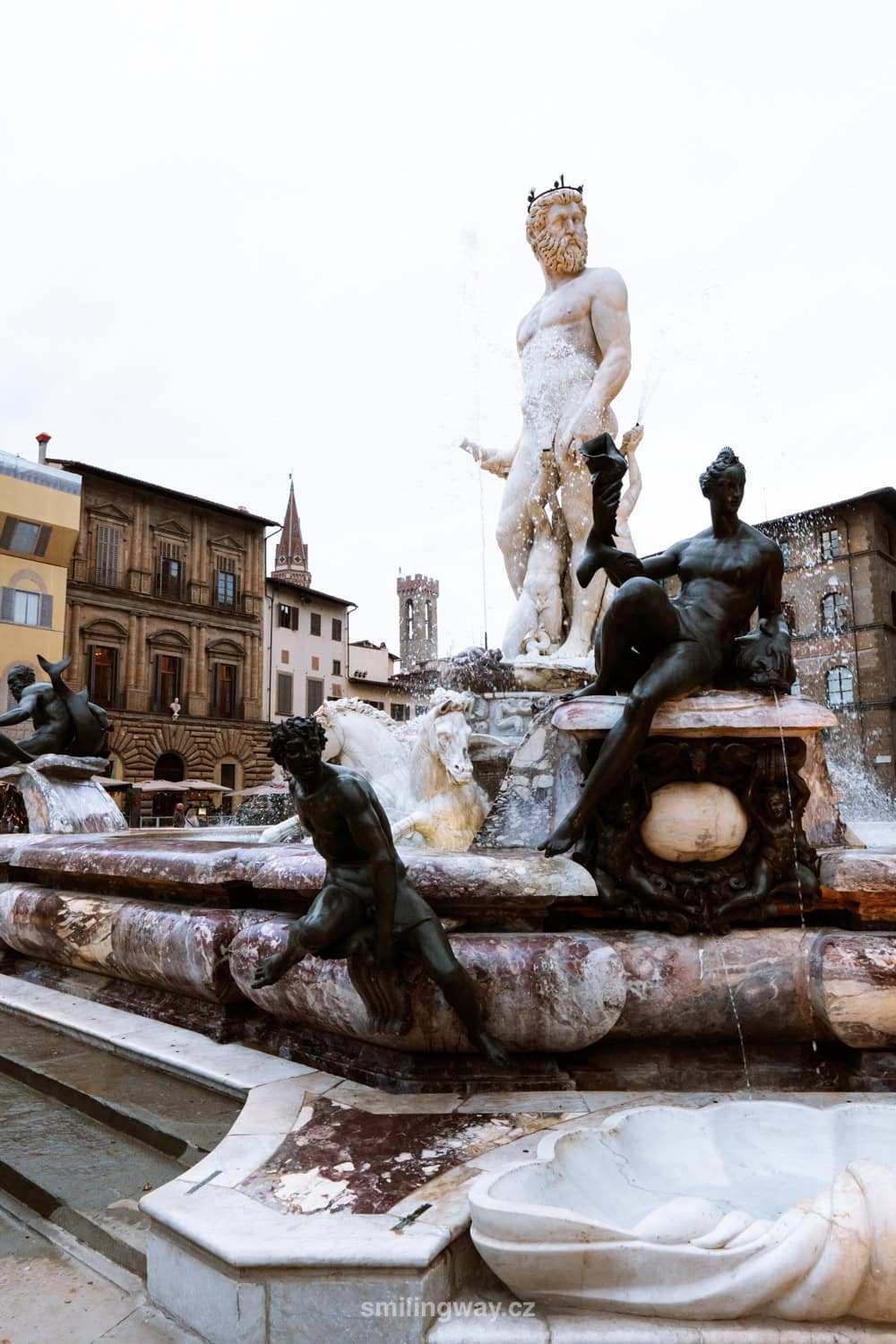
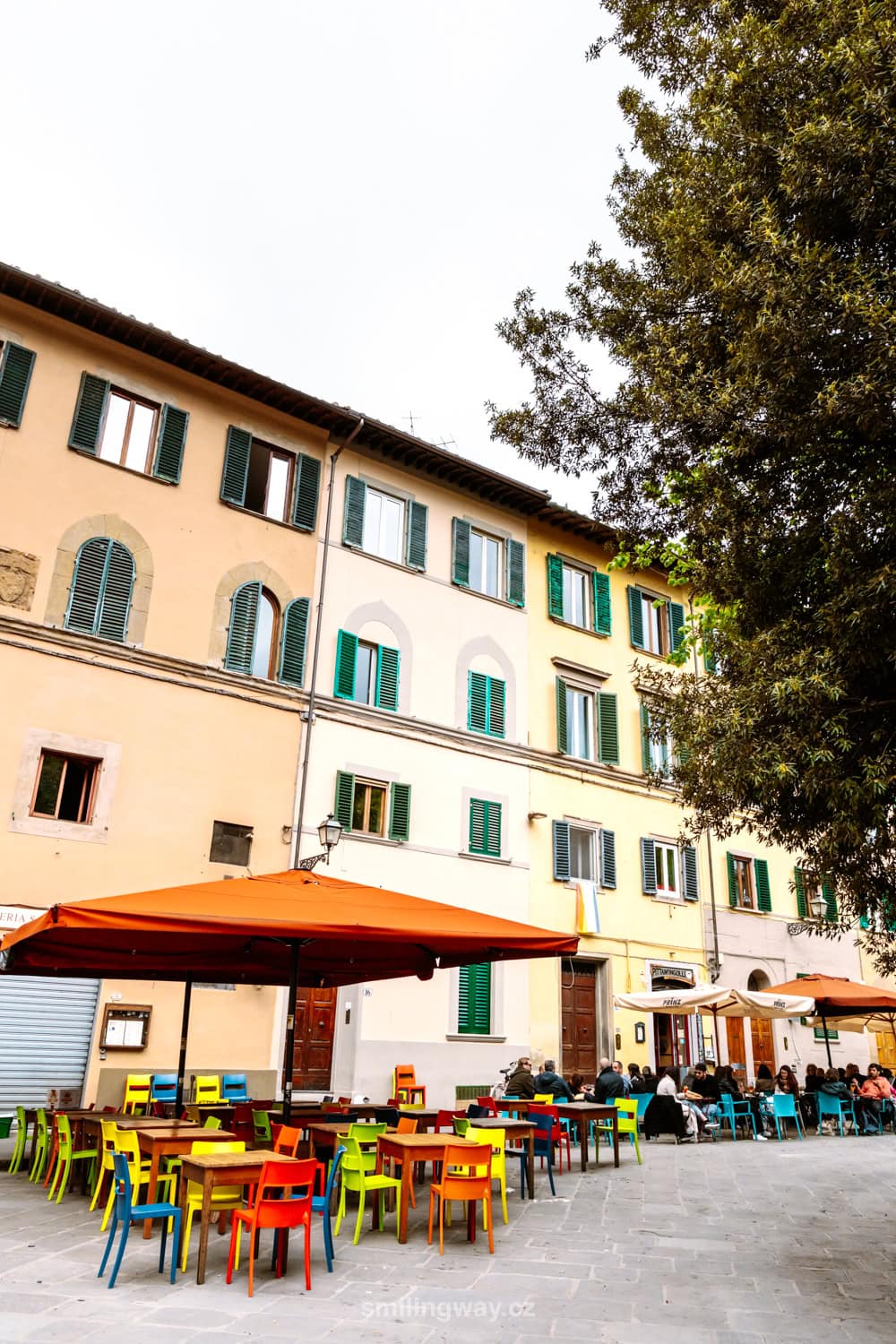
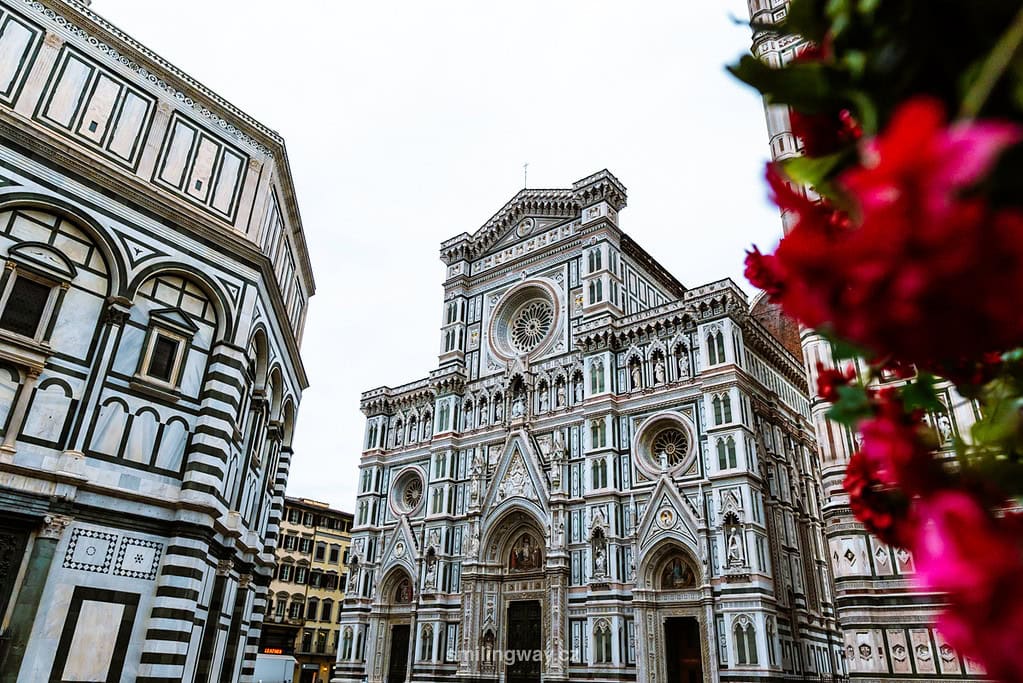
Lucca
Lucca is a historic town located north of Pisa. The town is a bit out of place among the more touristy cities of Pisa and Florence, but that doesn’t mean it doesn’t have something to offer. On the contrary. The town is authentic and has the right Tuscan atmosphere.
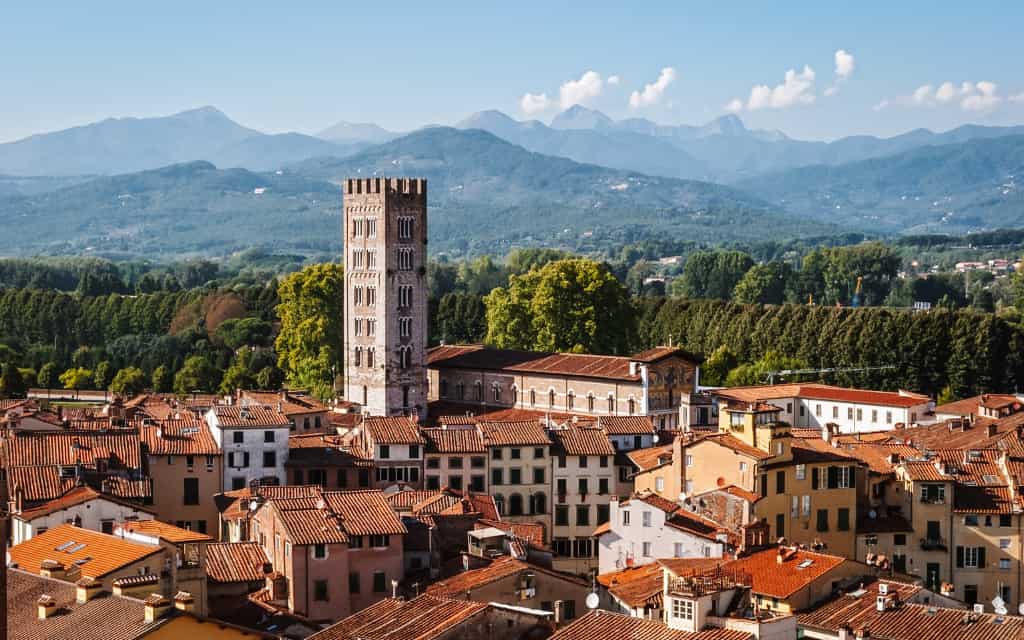
Cinque Terre
Looking at the Cinque Terre, you’ll probably be amazed at how incredible this place is.
Cinque Terre features five fishing villages wedged into steeply terraced cliffs along stretches of rocky coastline. The villages are characterised by pastel-painted houses, small harbours full of fishing boats and hiking trails with breathtaking views.
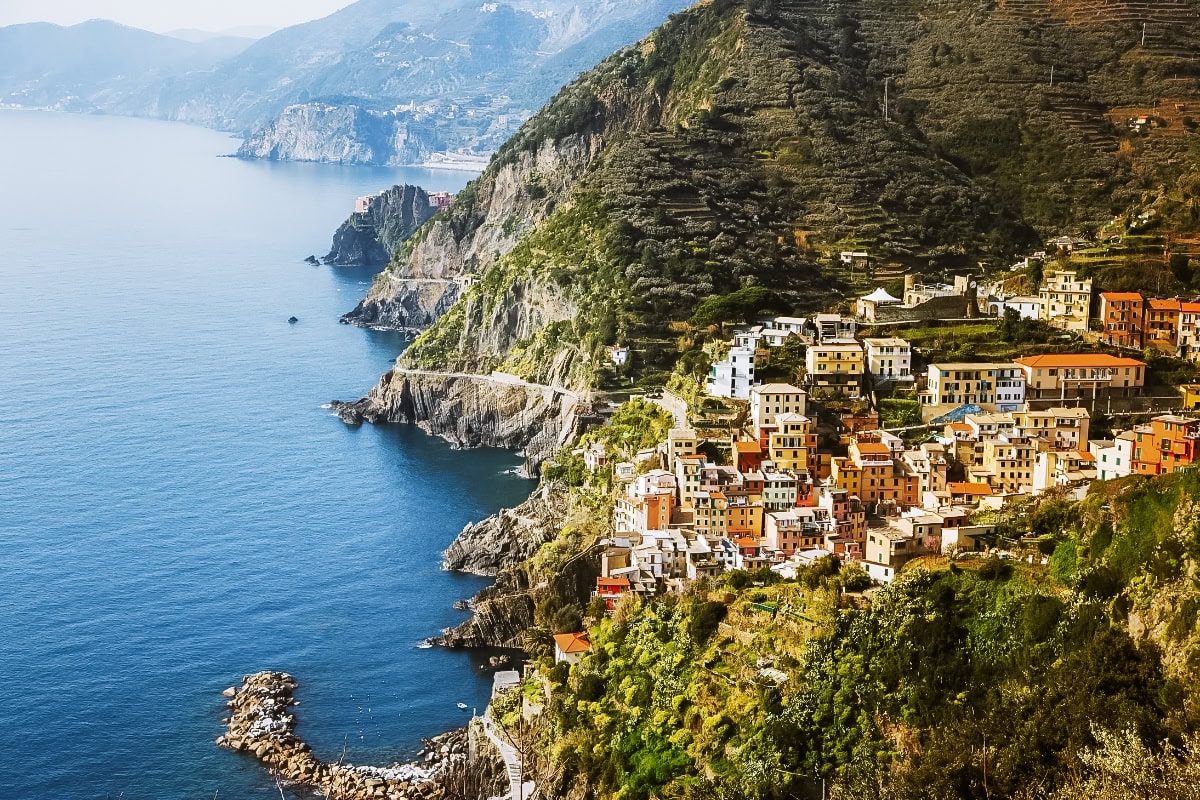
The gateway to the Cinque Terre is the town of La Spezia, a 1-hour train ride from Pisa. Regional trains leave from the same station for the villages of the Cinque Terre (Manarola is 14 minutes away, Riomaggiore 7 minutes).
Tuscan countryside
The Tuscan hills are dotted with olive groves, vineyards and ancient villages. The landscape is beautifully undulating and picturesque. It is in Tuscany that you will find some of the most famous wineries in the world, including the Chianti winery.
Enjoy the view from the Tuscan villa with a glass in hand, or stroll through the rolling countryside that offers far-reaching views.
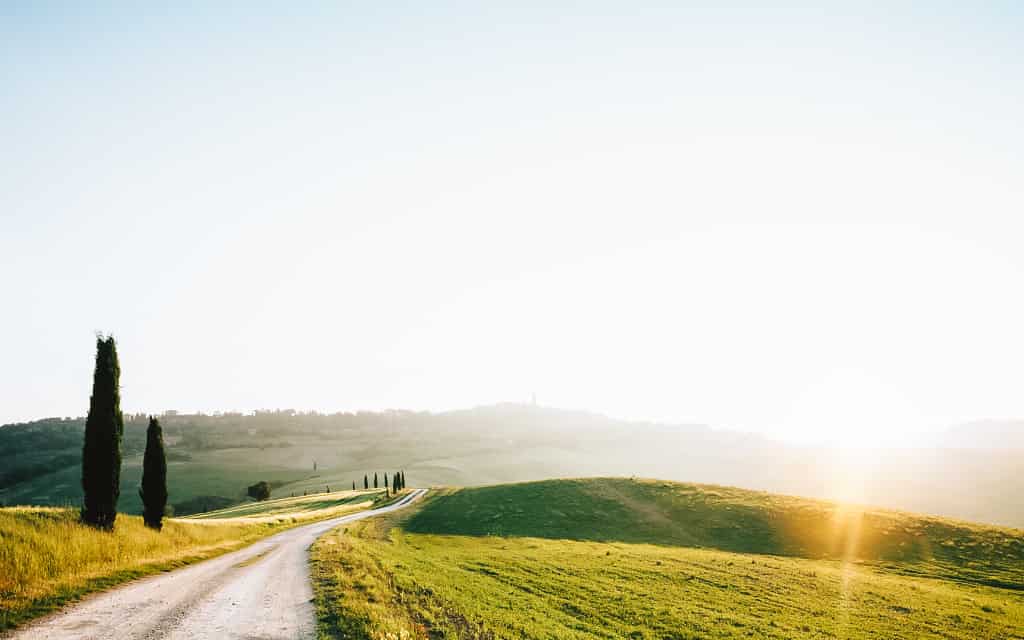
Where to stay in Pisa?
- Grand Hotel Duomo: 4* hotel with roof terrace and fantastic views of Piazza dei Miracoli
- Hotel Repubblica Marinara: Elegant four-star hotel on the edge of the centre with free parking
- Hotel Roma: A pleasant hotel in a medium price range, just 100 metres from Piazza dei Miracoli and the Leaning Tower.
- Hotel Helvetia: Cheap, clean hotel in the city centre
Hotels in Pisa 😴
How to get to Pisa, Italy?
Pisa is very accessible by air and by car. It has direct air links to a number of major European cities including Prague, Berlin, Vienna, Krakow and Amsterdam. Return tickets on low-cost airlines start from €25.
Pisa by car
A car is the ideal way to explore the surroundings of Pisa and the whole of Tuscany. Just bear in mind that there are restricted access points for the centre of Pisa.
If you plan to rent a car on the spot, our best experience is with Rentalcars.com which has the widest range at good prices. Insurance and free cancellation is a matter of course.
Driving directions to Pisa, Italy – charges
Fees vary depending on exactly where you are travelling from. If you go via Innsbruck, Austria, you will incur the following charges along the way:
- A motorway vignette for Austria for €11.50 for 10 days (motorbikes €4.60).
- Payment for crossing the Brenner Pass between Innsbruck and the Austrian-Italian border 11 €
- The toll in Italy is about 8-9 € per 100 km. You can pay the toll in cash or by card. Each payment gateway has a symbol at the top showing how you can pay.
The Brenner Pass vignette and payment for Austria can be purchased online in one place.
If you are driving from Vienna, you do not pass through the Brenner Pass. On the other hand, you will pay more in tolls. You can calculate the toll here.
Charges when travelling through Switzerland: theSwiss vignette for CHF 40. It is more expensive because only vignettes valid for 1 year are sold.
Petrol and diesel prices vary from country to country. The current fuel prices can be found at this link.
Follow this link for up-to-date information on traffic in Italy (tolls, closures, etc.). Google maps will also provide you with sufficient information.
Pisa airport
Pisa Airport is about 1.5 kilometres south of the city. It’s small, but sufficient if you don’t need the extra service and don’t mind sitting on the floor sometimes (there are fewer seats). The airport has only 1 terminal and flights arrive for most of Tuscany, so it is often crowded.
From the airport you can get to the city by the automated Pisamover train (driverless). There are blue ticket machines at the airport and at Pisa Centrale Station, where the train will take you. Or you can book your ticket in advance.
A one-way trip costs €6.50 and takes only 5 minutes. The Pisa mover is open daily from 6:00-00:00.
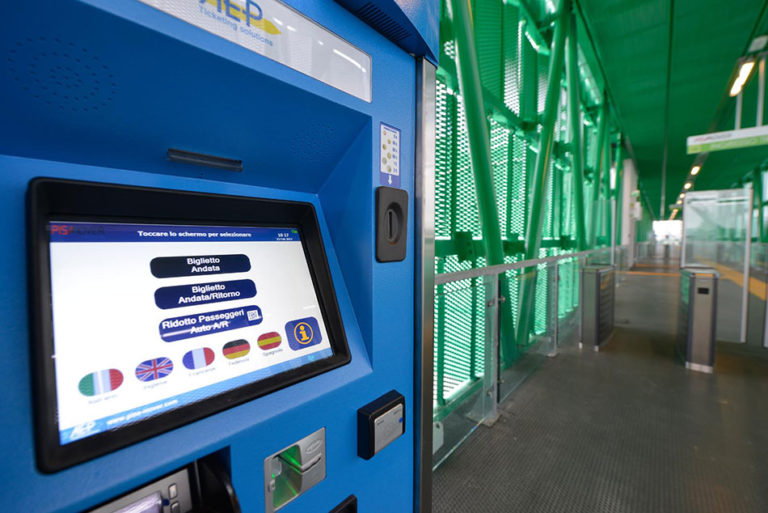
Stations and transport in Pisa
The centre of Pisa is small and easily walkable. Pisa Centrale Station is a 20-30 minute walk from Piazza dei Miracoli, plus a route through the historic centre of Pisa.
From Pisa Centrale there are regular services to the surrounding towns of Florence (1 h), La Spezia (48 min), Lucca (30 min), but also to smaller seaside towns (Torre del Lago, Viareggio and others).
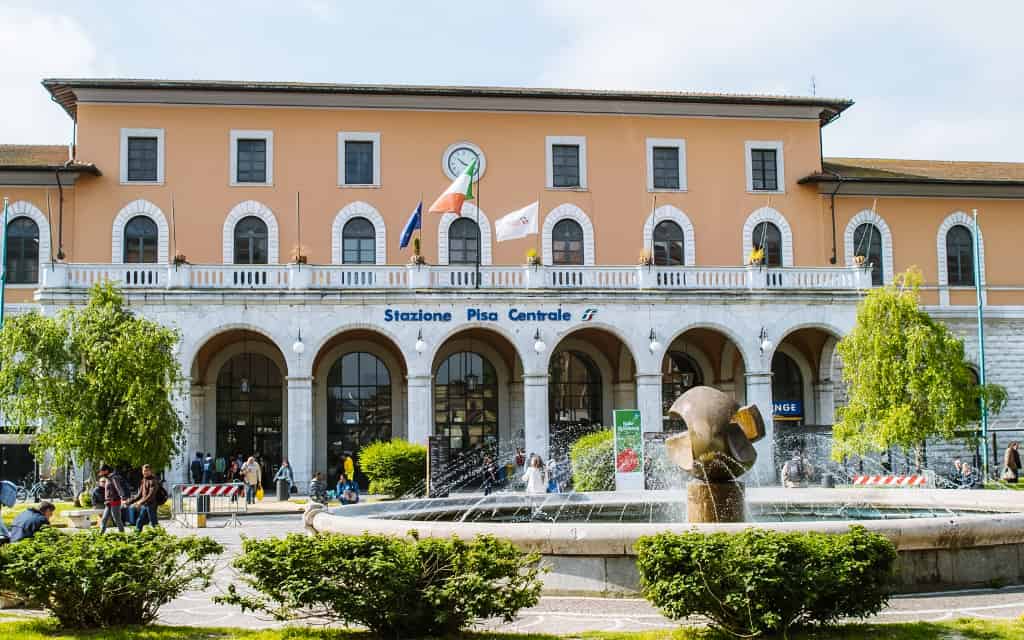
Buses
The city is served by buses, which also take you to the Leaning Tower. You can get on the bus at Sesta Porta Bus Station, which is located next to the train station. The ticket costs a few coins and you can buy it at the newsagent at the train station. It is valid for 70 minutes and is a transfer.
From the bus station, you can also reach the sea – for example, Marina di Pisa.
Pisa food, restaurants and ice cream
In Pisa, you can shop at Coop, Carrefour or Conad City supermarkets (you can find Conad City a short walk from the station if you want to buy food on the way to your accommodation, for example).
It would be a great shame to visit Italy and not have Italian gelato. What’s more, it was in nearby Florence that the gelato originated. The best gelateria, Gelateria De´Coltelli , is right by the river. They also have excellent gelato at La Bottega del Gelato.
For street food, try the Schiacciata Con Cecina of chickpeas and Tuscan focaccia bread, which crisps up beautifully. You can enjoy traditional Tuscan cuisine at Osteria di Culegna or Ristorante alle Bandierine in the centre.
Excellent local cuisine is served at Il Peperoncino and Ristorante Allabona Pisa. Or try the baguettes at L’Ostellino (they also have other street food). For tips on Tuscan cuisine, see the Tuscany guide.
You can also find all the restaurant tips in the Pisa map below.
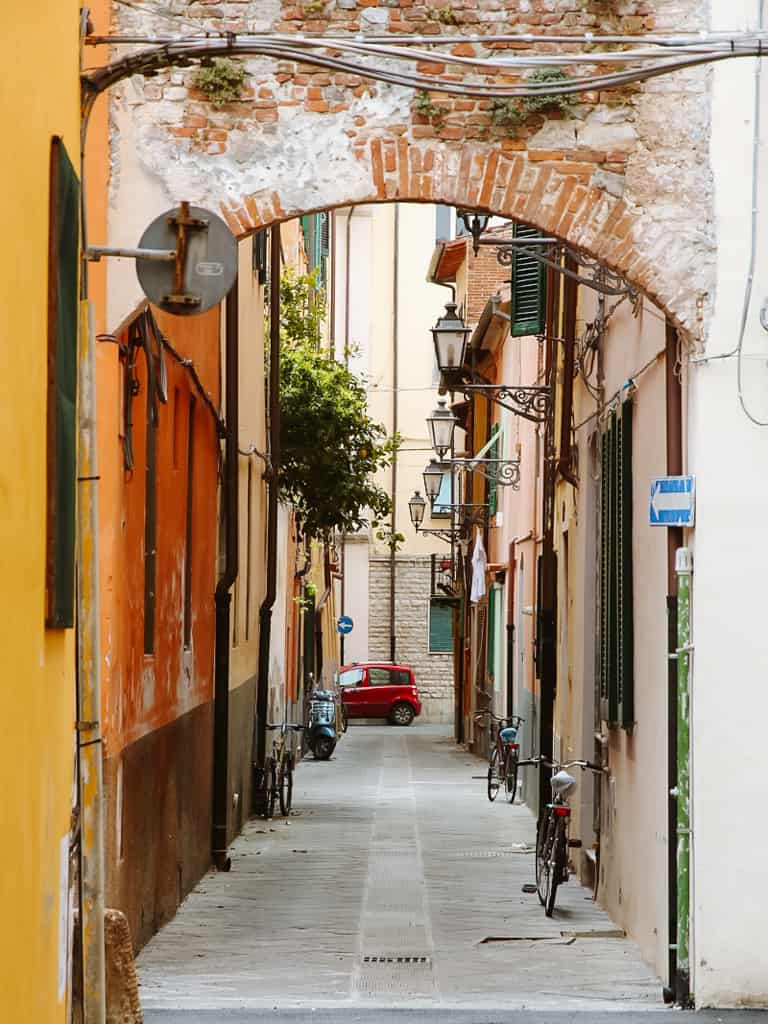
What to taste in Pisa, Italy?
The cuisine of Pisa, like most of Tuscany, is based on the Italian concept of “cucina povera” (translated as poor cuisine). This means that the food here is based on simplicity, with recipes often handed down from generation to generation and made with fresh local ingredients.
Here are some typical dishes you can try in Pisa:
- Pappa al Pomodoro: It is a thick and hearty soup made with tomatoes, bread, olive oil, garlic and basil.
- Cecìna: It is a thin savoury pancake made of chickpea flour, also known as “torta di ceci”. It is often served in a bun as a quick snack, known as “cecìna nel focaccia”.
- Risotto con le Cozze: It is a typical Pisan risotto with mussels.
- Pasta e Ceci: A simple pasta with chickpeas, often flavoured with rosemary.
- Duck Pisan style: slow-cooked duck with a unique combination of flavours, including orange, rosemary and olives.
- Bordatino Pisano: This is a soup made of cornmeal, cabbage, beans and other vegetables, traditionally served with slices of toasted bread.
- Torta co’ Bischeri: It is a traditional Pisan dessert, a cake filled with rice filling and flavoured with chocolate, candied fruit and a little liqueur.
In addition to typical cuisine, you can enjoy Tuscan products such as pecorino cheese, olive oil and wines from the area.
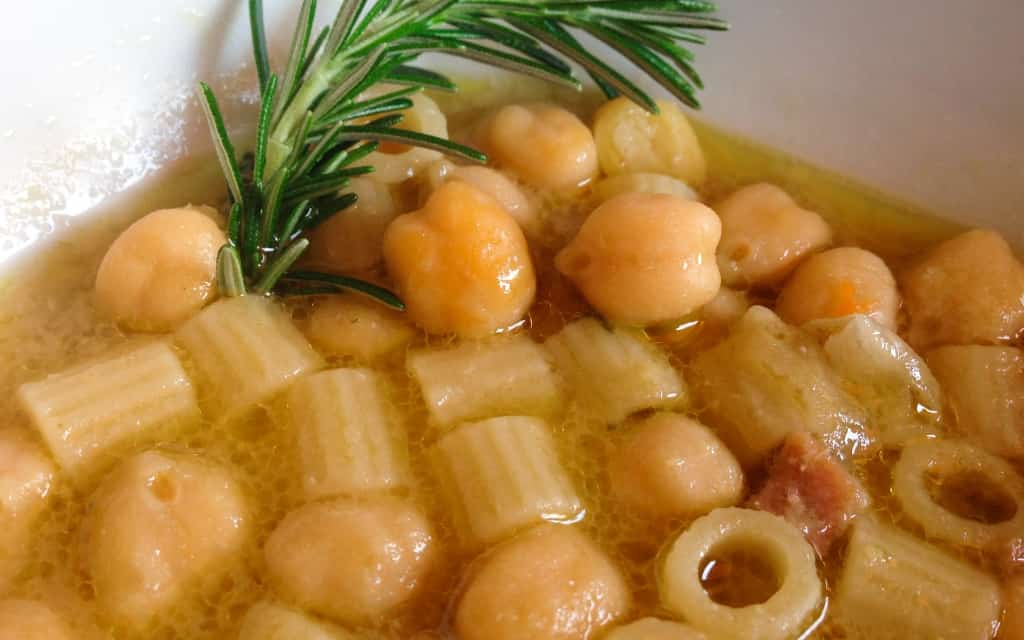
Prices in Pisa
For a meal in a cheap restaurant you will pay around 14-20 € and for a 3-course dinner for two around 70 €. Prices of basic food in Pisa are as follows:
- Milk 1 l – 1,46 €
- White bread 500 g – 1,96 €
- Eggs 12 pcs – 2,92 €
- Cheese 1 kg – 15 €
- Chicken breast 1 kg – 11,45 €
- Bananas 1 kg – 1,78 €
- Potatoes 1 kg – 1,67 €
- Water 1,5 l – 0,38 €
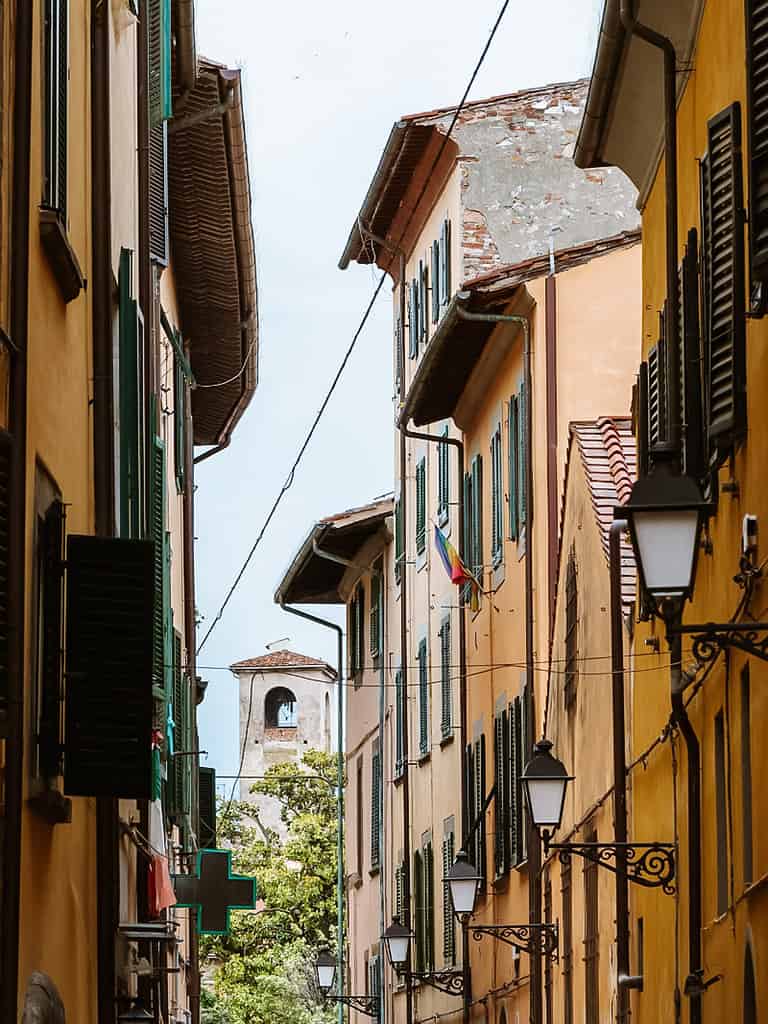
Pisa, Italy: what is the weather and when to visit?
The best time to visit Pisa, Italy depends on what you expect from your visit:
The best times to visit Pisa are spring (April to June) and autumn (September to October). During these periods, the weather is generally pleasant with mild temperatures and fewer people. The Tuscan landscape blooms in spring and the wine is harvested in autumn.
Summer (July to August): this is the peak tourist season, so attractions like the Leaning Tower of Pisa can be quite busy and prices are higher. The days are long and the temperatures are ideal for swimming in the nearby sea.
Winter (November to March) is the low season in Pisa. The weather can be cold and rainy (butstill pleasant to visit), but there are fewer tourists and you can find better deals on accommodation.
Hotels in Pisa 😴
Pisa practical information
Currency: euro (EUR)
Payment: For small purchases and payments, it is smaller to have cash with you, but otherwise you will pay by card in most places. Take a look at what fees your bank charges and what exchange rates are in order not to overdo it. We can recommend the World card from mBank for us. There are also plenty of ATMs in the city where you can withdraw cash if needed.
Electric socket: In Italy they use electrical sockets type C, F and L. Types C and F are compatible with most sockets in Europe and are widely used in northern Italy (including in hotels). L sockets are mainly found in older houses. If you are travelling from the UK or Ireland, you will need a socket reducer. In Italy, the electrical sockets used are types C, F and L. Types C and F are compatible with most sockets in Europe. Hotels and other tourist places have them too. Type L sockets are mainly found in older houses. It’s better to pack a reducer, but you can buy it in almost any store for a few tens of crowns if needed.
Language: The official language is Italian. Most of the time, however, you can also speak good English without any problems. Especially in tourist areas.
Safety: Pisa is generally a safe city. As in any tourist city, there is a risk of pickpocketing, so keep a close eye on your belongings and hide them well. Especially in places with a higher concentration of people.
Things to see and do in Pisa – Map
HOW TO USE THIS MAP: Above you will find a detailed map with tips on sights and interesting places to visit in Pisa. Click at the top left of the map to see separate layers with highlighted locations. You can hide and show the different layers or click on the icons on the map to see the names of the places I mention in the guide to Pisa, Italy. If you want to save the map, star it. For a larger version, click on the icon in the upper right corner.
The best booking resources for visiting Pisa
Via Booking.com we search for all accommodation. It is the largest accommodation portal in the world and you will find everything from modern hotels, cosy guesthouses to seaside villas.
Get Your Guide is a huge booking system for buying tickets, guided tours and all sorts of activities. In one place you can read other travellers’ experiences and book tickets to the Vatican Museums, a cruise on the Danube or a desert safari in Dubai.
If you are planning to rent a car in Tuscany, the best experience we have with Rentalcars.com which has the widest range at good prices. Insurance and free cancellation is included.
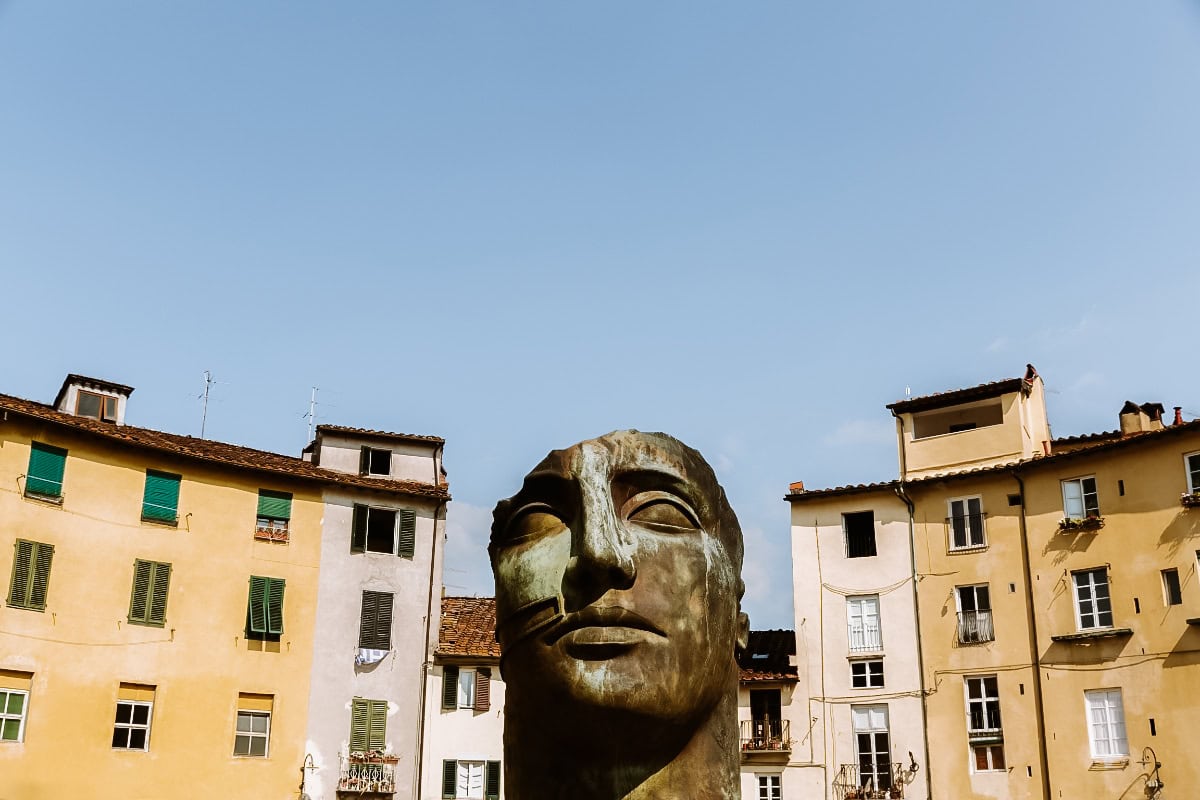
These were our tips on best things to do in Pisa and practical tips for visiting. Do you have a question? We’ll be happy to answer it in the comments below. Have a safe journey!
Plan your trip quickly and easily. If you buy something through our links, we get a small commission. You pay nothing extra. Thank you!
More information about Italy
TUSCANY: Check out our detailed guide to Florence. We have created an itinerary for 2 days in Florence (including a map and useful information).
Are you planning to explore the whole of Tuscany? We’ve put together our tips for what to see in Tuscany, including a map. Here is a detailed itinerary for a 5-7 day roadtrip in Tuscany.
ROME: Here’s a list of the most beautiful places in Rome. We have also created a detailed itinerary for 3 days in Rome.
NORTHERN ITALY: Here is the itinerary and route map for 2 days in Venice. See the most beautiful places to visit in Verona. Or enjoy a wonderful holiday at Lago di Garda. Get inspired with tips on sights and attractions to visit in Bologna.
Verona is another beautiful city that is definitely worth seeing.
ITALY: Get inspired by the most beautiful places in Italy. Or head to the north of Italy, which is full of beautiful nature, history and attractions.
Read even more tips on travelling in Italy.
Summary: Things to do in Pisa, Italy
Among the most beautiful sights in Pisa is the Piazza dei Miracoli with its Leaning Tower, imposing cathedral and baptistery. These are the places for which tourists from all over the world come here. But there are other places to see in Pisa – the historic centre with Piazza dei Cavalieri and the Church of Santa Maria della Spina.
Pisa is located in the north of Tuscany and has many unique places nearby – Florence, Lucca, Siena, the sea, the Apuan Alps and endless fields of vineyards.
Pisa is located in the north-west of Tuscany. Just 10 km from the Ligurian Sea and 80 km from Florence. It’s a city of nearly a hundred thousand people, famous for its Miracle Square, Leaning Tower, magnificent cathedral and winding historic streets. It is one of the most beautiful cities in Italy.
